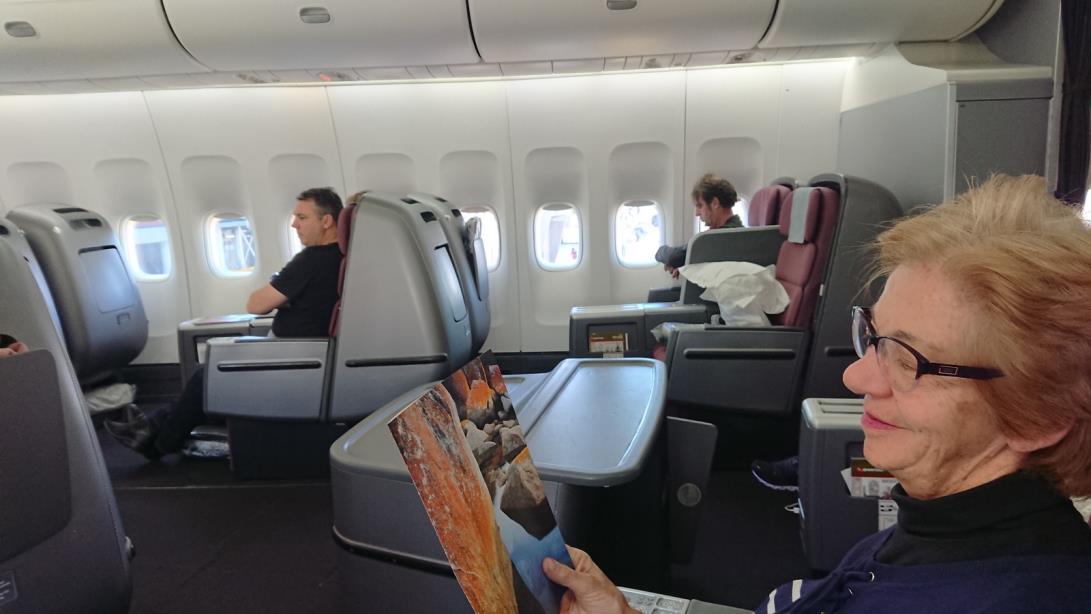Ecuador and Peru 2019
October 25, 2019
Ecuador & Peru – July/August 2019
Part 1 – Ecuador and the Tren Crucero
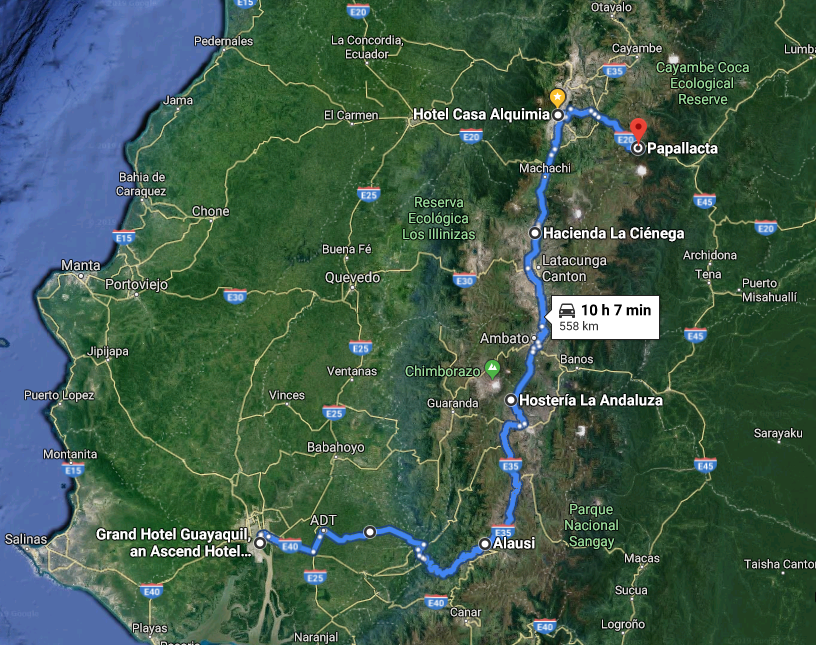
The first part of our South Americn holiday was an adventure in Ecuador. We took the Tren Crucero from the tropical lowlands at Guayaquil up the the Avenue of Volcanoes and the capital Quito.
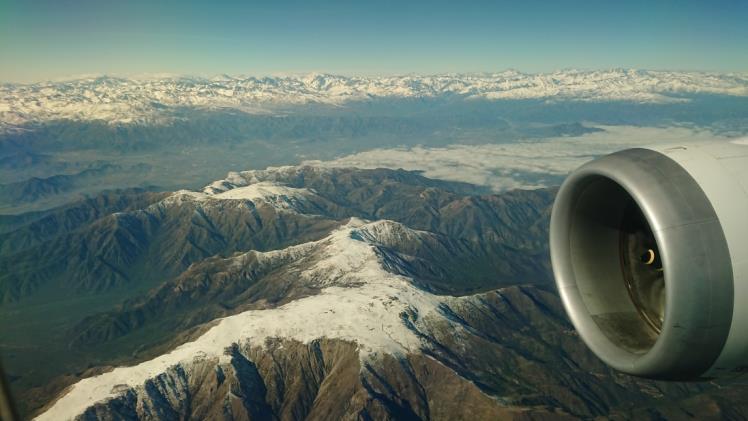
Arriving at Santiago, Chile
Our marathon journey to Ecuador started on a rainy morning in Sydney, though we managed to keep dry getting to the airport. In a first for us we had our big case wrapped as it was going to be sitting in Santiago for 8 hours.
4th July
On our way to South America
It took us 3 flights and 28 hours to get from Sydney to Ecuador – as the flights didn’t connect. We invested in Business Class flights. Although the service on LATAM was hardly spectacular it did give us the opportunity to grab some sleep, and access to comfortable lounges to wait out our flight connections.
Business class was quite empty on the LATAM flight to New Zealand. The short flight passed quickly with a light brunch and we both watched Three Billboards Outside Ebbing, Missouri – which neither of us saw when it was on release. New Zealand welcomed us with more heavy rain. We made our way to the Qantas lounge to sample NZ ice cream and pear cider. An hour later we reboarded the same plane and same seats for the onward flight on to Chile
The eleven hour trans-Pacific flight was pretty uneventful, and we both got a good sleep, even though when we arrived in Chile it was still the 4th July! The views of the snow-capped Andes on approach to Santiago Airport were stunning – until we descended into the city pollution. After disembarking we had a lot of trouble finding the business class Lounge. There was no sign posting at all and we had to search to find a lift to the 4th floor. The elusive refurbished LATAM lounge was comfortable and quiet. We had showers and settled in for an 8 hour layover.
Sunset in Santiago came and went. Time spent in the lounge started to drag – broken only by a sampling of the Chilean wines on offer. When finally our flight to Guyaquil started boarding we had to wait outside for a bus which took us to a ‘mature’ A319 parked as far away from the terminal as it could. We were both feeling tired and cold as we were dressed for arrival in tropical Guyaquil.
Arrival in Ecuador went smoothly, we found the fee-free ATM in the arrivals hall and our hotel transfer arrived shortly afterwards. It was finally the 5th July and about half-past one when we reached the Grand Hotel in the centre of the city and crashed into bed.
5th July
Guayaquil
Guayaquil isn’t exactly a tourist destination; it is a busy port town that just happens to be the starting point of the Tren Crucero railway. The guide books make it clear that this is a dangerous place for tourists, but from our hotel in the centre we saw little evidence of crime. That was no doubt thanks to the police on every street corner during the day. By night we were safely tucked away in our room.
After a reasonably good night’s sleep, facilitated by sheer exhaustion, we woke at a reasonable time to enjoy breakfast. The highlight of our first breakfast in South America was some fried plantain and cheese balls.
After sorting the contents of our three cases it was time to take a look at the town. Guayaquil has a reputation as being a pretty dangerous city, but by day there was nothing edgy about it, and the traffic was better behaved than in most South-East Asian cities. The Parque de las Iguanas a block away from our hotel had plenty of docile lizards and also some terrapins that looked just like rocks from a distance. Although we were close to the equator, the temperature was forecast to be only 28 degrees, with the sun hidden behind heavy cloud.
Across a busy road from the Town Hall was the Malecon (riverside walk) swarming with police and security guards. It felt unexpectedly safe. The Rio Guayas was wide and brown with a visible tidal flow – it reminded us of the Mekong in Saigon. At the north end of the Malecon was the air-conditioned anthropology and contemporary art museum – strange bedfellows indeed! We looked round the exhibition on Ecuadorian prehistory and found it surprisingly interesting given that the captions were only in Spanish and no exhibits were dated!
Leaving the waterfront we climbed the narrow laneways up though Las Penas to the light house at the top of the hill. The houses were colourful but close up it was obvious that only the front walls had been painted – the rest of the buildings were pretty squalid. The view from the light house was hazy. But the exercise after sitting on a plane was welcome.
A smart restaurant – ‘Sweet & Coffee’ on the Malecon attracted us for lunch. Adrian tried an Ecuadorian speciality – Humitas – made with ground corn and cheese. Our feet were starting to get sore so we headed back to the hotel to go swimming. The pool was squeezed in at the ground level into a small area between the back of the hotel and the cathedral apse, but it was nicely landscaped with a tropical hanging garden and a huge illuminated iguana sculpture. Unusually the ‘pool side’ sun loungers were 2 floors up.
That evening we indulged in cocktails – one complimentary followed by two happy hour Pisco Sours. We ate in the hotel restaurant which was quiet and cold. The food was good and whilst we were eating three guitarists played some local tunes for us. One of them was blind (this is an observation not a criticism of his playing!).
6th – 9th July
The Tren Crucero from Guayaquil to Quito
The Ecuadorian government has spent a lot of money restoring the Guayaquil-Quito railway as a tourist attraction. Unfortunately keeping the line open with earthquakes triggering landslides and El Nino rains washing away the rails is a challenge. In 2019 the line was broken in several places so we were not able to take the same train for the entire 446km trip. This no doubt would reduce the journey’s attraction to train enthusiasts, but it gave us the opportunity to include more interesting side trips by bus.
We were a small group of 15 or so passengers on a 6 coach train so there was plenty of space to more around. The particular attraction was the lounge car at the rear of the train which also had an open viewing platform.
Tren Equador is a labour intensive operation, and they have a policy to engage with the local communities. So although our 4 day trip was a luxury experience we were not isolated from the locals. And as a result of this inclusive policy the train (and passengers) were welcomed wherever it went.
Train Crucero Day 1
The jet lag kicked in and after a disturbed night we were awake before the alarm went off at 6. That gave us time for a rushed breakfast before checking out and getting a taxi across the river to Duran. Checking in for the Tren Crucero was relaxed as each guest waited to have their passport and luggage checked. We met a couple from New Zealand who had been on the same flight across the Pacific. The suitcases were packed into a minibus, which would also be used to transport us between the various excursions on the trip.
We were lucky to have a bright red steam engine to haul us on the flat to the first station at Yaguachi where we watched as they changed over to a diesel electric for the rest of the trip. A morning snack and welcome drink were served in one of the period dining coaches and then we retired to watch the passing scenery from the lounge car at the rear of the train. After passing down the main street of a couple of towns and winding through plantations we reached a halt where we disembarked to visit Hacienda La Danesca.
The Hacienda is a family-owned working cacao and dairy farm, and before having lunch we were shown round a cacoa plantation and had an informative demonstration on how chocolate is prepared. We had to leave the railway behind for the rest of the day, because as the line winds its way up the rivers into the mountains the track had suffered a number of washouts. We followed the railway route in a minibus, sticking as far as possible to the valley used by the train; we even stopped at two stations that were not receiving a rail service.
After Bucay station where a train was stranded there by track failures, we drove up into the clouds, following an unsurfaced road high above the railway line. The road climbed relentlessly in zero visibility till we dropped down to Huigra station at 1255m above sea level. The platform was unusual because it was level, but the railway tracks were climbing steeply through the station. A local band and dancers gave a short performance welcoming us to the mountains.
The minibus took us back into the clouds for a short trip to Alausi where we stayed overnight in a converted colonial house in the centre of town. There was time to grab a quick shower before the hot water ran out, and then to join the group for a simple meal in a restaurant on the main square. At 2340m above sea level we both started to feel the effects of exercise at altitude with headaches, pounding hearts and a general heavy feeling. With temperatures dipping down to single figures overnight we had no hesitation in packing away our tropical clothing.
 A steam engine heads the Tren Crucero at Duran Station A steam engine heads the Tren Crucero at Duran Station |
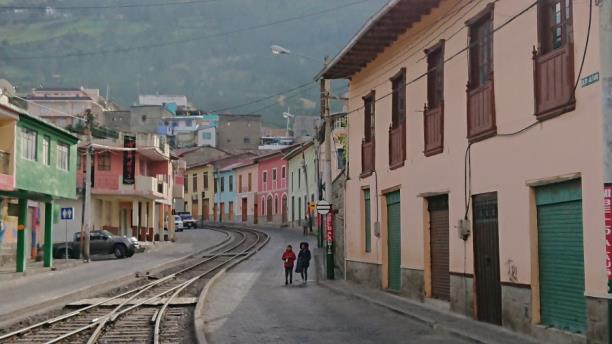
Railway running through the streets of Alausi |
Train Crucero Day 2
The low cloud had lifted overnight and the blue sky belied the bitter air temperatures as we walked down to the station. On a Sunday morning, Alausi was busy with day trippers. We had private use of our own carriage on the Devil’s Nose train at the back of the train. There was also visible security for us – even though the town felt safe, Train Crucero wasn’t taking any chances with its guests!
The train descended 500m down to Sibambe – first by taking a long loop into a lovely green valley with a rushing mountain stream. Then when even that lengthening of the track failed to drop enough height, it took two switchbacks on a bare mountainside to take it down to Sibambe Station. All the time the track dropped at a steady 5 percent gradient
Whilst the train rested and the engine was moved to the other end of the train, we had a look round a recreated indigenous village showcasing a pre-Hispanic lifestyle. That was followed with a dance demonstration. It was challenging (and probably unsafe) to join in too vigorously at this altitude. As the train climbed back up the switchbacks the sun came out.
The Ecuadorian trains were unlike any railway we had previously experienced:
- The track was unfenced. In the towns it just ran down the middle of the road like a tram. In the countryside animals had to be tethered to stop them wandering onto the track.
- There were no barriers on the many level crossings. A team of security riders on motor bikes would race ahead of every train and ensure that traffic was stopped as the train arrived.
- Turntables were rare. Instead most stations had a triangular junction (a Wye) so that an engine could be turned round.
- There were no signals. Collisions were apparently avoided by restricting the number of train movements.
- Ruling gradients of more than 5% were common, but the trains did not resort to rack and pinion for traction, just sand!
- There were numerous tight curves where the rear of the train could become derailed, so the guards would wave to the engine driver to confirm everything was OK.
Because the railway line was blocked by an unsafe bridge north of Alausi we had the opportunity to look round the town market before continuing by bus. The busy market had a mix of locals, many in traditional costumes, and some in modern dress.
We took the bus to the top of the first pass at Palmira. At 3240m above sea level the landscape was a desert because of acidic lava flows and the only thing that grew were pine trees. We were met there by our new train which was hauled by a modern diesel electric engine. Lunch was served on the train as we dropped down into the Avenue of the Volcanoes.
There was a brief stop to look at Ecuador’s oldest church in Balvanera. Unfortunately although the church was built in 1534 it was levelled by an earthquake in 1897. Subsequently it was hastily reconstructed but in a rather random order destroying whatever architectural integrity it once had. To look inside the church you had to pay to go through the religious museum, so we contented ourselves with a view from the door.
Riobamba station had an interesting museum with maps of the railway line and other artefacts. We then transferred by minibus to our bed for the night at Hacienda Andalucia. There we were welcomed with a warm alcoholic drink based on fruit juice and aguadiente (Canelazo /naranjillaz was subsequently served many times to us in the Ecuadorian highlands). Whilst Adrian grabbed the hot water for a shower Megan took a historic tour round the old hacienda (1771) which included a room where Simon Boliva slept. Dinner in the hotel was well presented but a bit tasteless. We were invited to sit with Maryellen and Jackie, an interesting couple from Perth. There was live music – and we bought a cd – our only souvenir of the holiday!
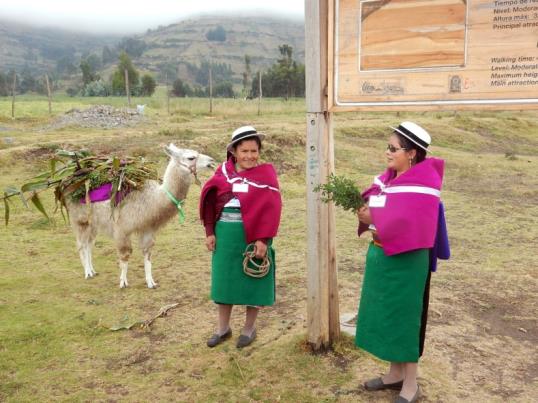 |
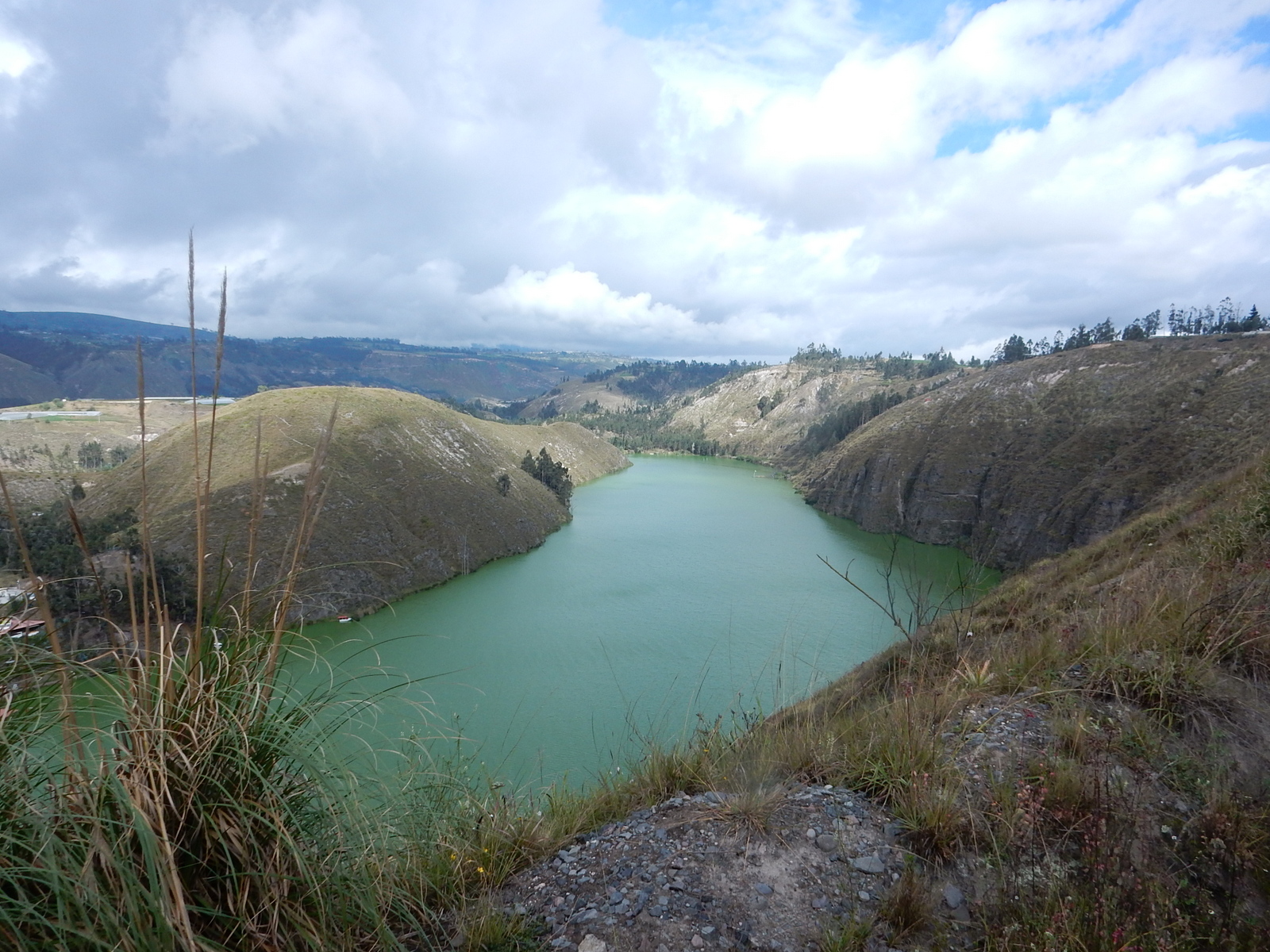 |
Train Crucero Day 3
It was too cloudy to see Chimbarosa from the hotel so it was good we didn’t get up particularly early to have a look. Whilst we waited for the bus we looked round the gallery in the old hacienda which was stuffed with museum exhibits. We re-joined the train back at Riobamba station and after about 30 minutes reached Jatari Campesino (3224m). There was no platform or station here but we disembarked and were greeted by school children, a rustic dance, and a shower of ice cold rain. Two women from the indigenous community were there to walk us to the nearby La Moya village. They also had a Lama along for show, carrying its breakfast on its back. Like many of the collaborations that Tren Crucero had put in place, this visit was clearly a way to empower the indigenous women whose life otherwise consisted of little more than learning to spin, learning to weave, and getting married. We were shown how Caca de Pero is made (a sweet corn snack whose name translates in English as Dog Poo). Various herbs are also used in tea to help with altitude sickness (but not Cocoa leaves which are not legal in Ecuador).
The train then took us on to the highest station on the line, Urbina at just over 3500m. The station building had a small museum about the ice cutters who used to cut ice from glaciers high up on Chimborazo and sell it in the town. The last ice cutter is getting very old now – so his daughter gave a presentation about the literally dying industry, and his brother gave us a taste of gelato made with ice from the mountain. The ice was unusual as it is very old, and has gas bubbles in it. Across the road from the station there was a hostel/camping area that is used by climbers acclimatising to high altitude. It had a display of lamas (camel-like face) and alpacas (more fur and sheep-like face), a garden featuring high altitude plants, and some reproduction indigenous houses. Once again we had a delicious lunch on the train whilst we wound down into a fertile deep valley. The fields of quinoa were particularly attractive colours.
There was a ‘technical stop’ in Ambato as the train crew changed over, and we took on board some “Devils´of Pillaro” who gave us a spirited dance display in the limited corridor space in the dining car.
We passed the Laguna de Yambo on the right hand side, and the train slowed down so we could all take pictures. The lake is tinted green by the algae in it. When we reached Latatunga we transferred into the minibus for the trip to our overnight Hacienda which was in the next town of Lasso (it wasn’t clear why we couldn’t disembark at the station there). The snow on Cotopaxi was visible, but the top of the volcano was shrouded in cloud. Our hotel, La Cienega is one of the oldest colonial haciendas in Ecuador, with more than 400 years of history. We were given a vast comfortable three bed room on the ground floor complete with a wood fire. We only briefly saw hot water, but it was nice to warm ourselves round the fire. All we needed was a hot chocolate!
The Hacienda had its own chapel. On the top floor over the entrance there was a suite that was once used by the Prussian polymath and explorer Humboldt.
The group meal was very average, with what seemed to be a typical blandness (this may have been a side effect of altitude on our taste buds). After the meal the hotel charged for water. We refused to pay $5 for two bottles of water as it wasn’t listed as an extra on the Tren Crucero contract – that attempt to overcharge soured our impressions of the hotel.
Train Crucero Day 4
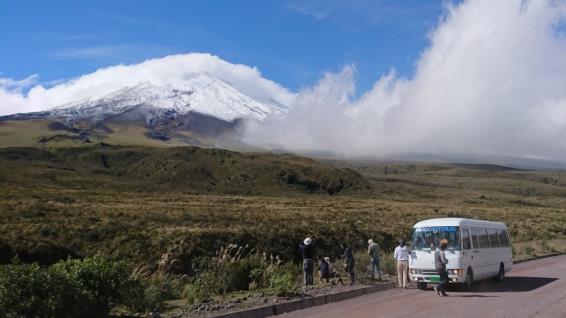
Cotopaxi Volcano appears briefly from the clouds |
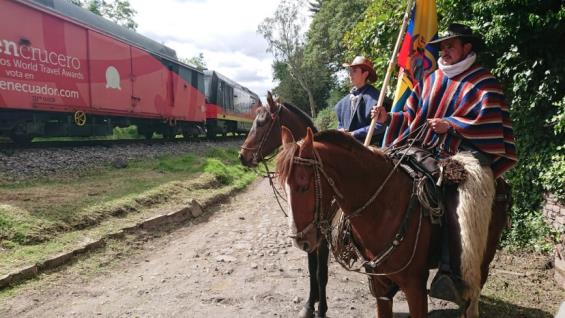
Demonstration of Chagra cowboy skills |
We had a relaxed start to the day for a change, but still no hot water. Breakfast was served by a waiter which was less convenient that the usual grab-what-you-want buffet. Again Cotopaxi was in cloud and not visible from the top floor of the Hacienda. Our minibus took us to Cotapaxi National Park skipping about 40km of the railway. Even with our leisurely departure we were in the park before the day tours from Quito arrived. In the car park at the visitor centre we were served a hot herbal drink (for the altitude) and lumps of raw sugar (for energy). On the way up to Limplopungo Lake our guide described the various types of pine trees growing, but pronounced the plural of pine as “penis” which had us crippled with laughter! Smart eyed Megan noticed that the clouds on the volcano had cleared momentarily so we stopped and grabbed our only pictures of the summit.
Cotopaxi was active so we couldn’t go up to the refuge. Instead we explored Limplopungo lake at 3900m; in a strong wind it was bitterly cold. Hardy brumbies grazed on the flat plateau (caused by the lake shrinking) but they were allowed in the National Park because they provide food for condors. We walked round the lake enjoying the many different alpine flowers and the warm sunshine when we could get shelter from the wind.
Our train was waiting for us at the alpine styled station of El Boliche, a summit on the line at 3547m. We enjoyed good views of Ruminani volcano from the train as it descended to Machachi Station. There we were treated to a five course lunch in Hosteria La Estacion which started with Canelazo and finished with cape goosebery and gelato. There was fake live music with someone miming to a CD which he subsequently tried to sell us.
Just a short distance further down the line we visited Hacienda La Alegria by the side of the railway. The farm built in 1911 offers house riding. They had some riders to give us a demonstration of Chagra cowboy skills. The paddock next door with alpacas was more of a hit with us! They gave us a quick look through the house (the same age as our house in Cammeray but very different) before we boarded the train for the final leg to Quito. In the middle of urban sprawl we had a technical stop ostensibly to refuel the engine but in fact they also coupled a steam engine onto the front of the train without telling us! Soon after we crossed the busy Pan-American Highway then crawled through the industrial outskirts of Quito. Quito station had an unusual design for a terminus station because the track looped round and the platform was curved. The meant that trains did not have to shunt their engines round.
We said farewells to the group then jumped in our own transfer car which had been provided in lieu of staying the final night in the included Swisotel. It was difficult to reach the Casa Alquimia in the centre of the old town, as many nearby roads were closed to traffic in the evening. The hotel in a colonial house dating back to 1600 was renovated by two retired lawyers. It served both as a museum and as lodging. Behind wooden doors our room was quaint, furnished with antiques, but lacking any hanging space. Our balcony, which overlooked a noisy street, took some getting used to after the quiet of country haciendas. We were exhausted but had to eat. so we took a quick walk round the corner to the eat street, La Ronda. We ate in a restaurant (Los Geranios) that didn’t have touts outside drumming up trade. It was a bit expensive but Adrian was able to try the local specialty – goat stew.
10th – 13th July
Quito
Quito was where Adrian’s Latin American holiday had finished up in 1982. He had fond memories of the town (if not its food) and so it was interesting seeing how it had changed in 35 years. It turned out that the city centre had retained its charm with colonial buildings and views of mountains on every street. We enjoyed staying right in the heart of town in a historic house, though getting to and from the hotel by car was challenging. And although there were plenty of restaurants to choose from the food still failed to excite.
Quito Day 1
It was nice not to have to get up in rush, or in fact have to do anything! Breakfast was served by the owners in a sun room on the roof. The aromatic tea was a hit with Megan. After visiting an ATM on the Plaza de la Independencia we walked a few blocks to Plaza Huerto to join a free walking tour of the old city. We were early so had a coffee whilst we waited. The tour was so popular that it was split into two groups; we joined up with a small group of young female independent travellers. The tour was very informative, and not just an excuse to take us to tourist traps. After the Plaza de la Independencia we sat in the courtyard of the Centro Cultural Metropolitano to be told about the fascinating history of Ecuador’s presidents (mostly in jail) and to the Central Bank to hear about the financial crisis and adoption of the US dollar. We looked inside San Francisco church and were introduced to the very life-like sculpture from the Quito school. Then in the plaza outside the church there was the obligatory chocolate shop to visit – at least there was a lot of product to taste. The walking tour finished in the eat street – La Ronda where we had dined the previous evening.
After the tour we headed back to the old archbishop’s palace for a recommended ‘menu’ almuerzo. Then we revisited the Centro Cultural to take pictures from the roof. We paid to visit the Iglesia de la Compañía de Jesús, built from 1605 to 1765 and known for its elaborately carved interior. Entrance included a guided tour, so we asked for one, even though it was delivered in largely incomprehensible Spanish. The final stop on our first day sightseeing in Quito was the Casa del Alabaldo which contained a well laid out exhibition of pre Colombian sculpture. The pottery was surprisingly attractive even though the dates were vague.
In the evening we revisited the same restaurant in La Ronda for dinner. The portions were large but not particularly tasty. We spiced up the meal by drinking Micheladas – a “cerveza preparada “(a mix of beer and spices).
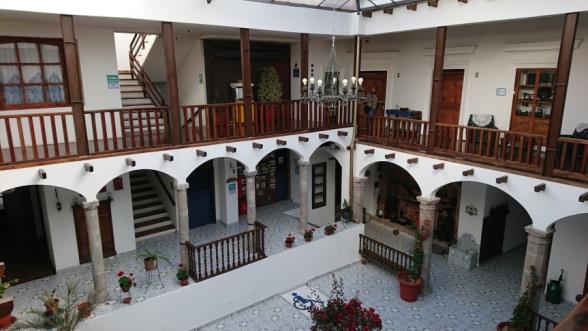
Casa Alquimia, Quito |
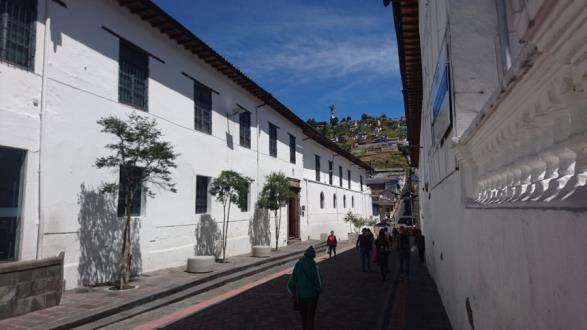
Quito streetscape with Panecillo in the distance |
Quito Day 2
On our second day in Quito we wanted to see more of the city so decided to buy tickets for the hop-on hop-off double decker bus. This wasn’t simple as the bus routes had been changed (probably to avoid the street closures associated with the Metro construction) and the website had not been updated. To ensure we had up-to-date information we bought our seniors discount tickets at the bus office in the tourist information centre on the Plaza de la Indepencia. We waited on a nominated street corner by the Plaza San Francisco, and eventually our bus turned up.
The first stop we made was at the top of the hill that overlooks the old town – Panecillo. The winged statue on the top is not of the Virgin Mary, but the Woman of the Apocalypse, as described in the Book of Revelation.
Book of Revelation 12, 14
But the woman was given two wings of the great eagle so she could fly to her place in the desert, where, far from the serpent, she was taken care of…
We paid $1 to go up to the viewing platform on the statue – the view was straight into the sun, but was a great introduction to the geography of the city. The bus then headed up the east side of the city, with occasional glimpses down 500m into the valley of Tumbaco. The new city is not attractive and was gridlocked; somehow the bus kept reasonably to its timetable. On the return route we got off at the Mercardo Artesanal, a city block dedicated to handicraft stores. We soon confirmed that there weren’t any souvenirs we wanted to buy. Close-by was the new national museum of Ecuador which had modern well laid out displays and translations to English and Quechua. One special exhibition was on gender fluidity in pre-Hispanic Ecuadorian pottery. After a coffee and sugar hit in Sweet & Coffee we jumped on a bus back to Plaza San Francisco. That evening we ate at a Bohemian cafe on La Ronda and enjoyed pizza & lasagne. It was a quiet evening and we chatted in Spanish with the owner.
Quito Day 3
After two days looking round Quito it was time to head out into the countryside. We booked a tour to the thermal springs at Papallacta with a private car and driver. Leaving Quito to the east we dropped down into the valley of Tumbaco then climbed to 4000m passing over the Eastern Cordilleras. The trip took about 90 minutes on good fast roads. Papallacta was just below the cloud base at 3300m in a valley that leads down to the Amazon basin. We started our visit with a gentle nature walk beside a gushing mountain stream, and then we headed for the baths. The facilities in the public baths (Balneario) were very smart – the showers and changing rooms had heated floors, and we each had a wicker basket to keep our towels and belongings. Getting undressed the first time was difficult as the air was quite cool, but once we had warmed up in the water we didn’t seem to notice the cold. There were several baths of varying temperatures; the hottest was almost unbearably hot. We were lucky in that we found a private pool which we had all to ourselves. The sun came out and we quickly got a sun tan at such a high altitude.
For lunch we exited the baths and visited a local restaurant just outside the gates. We enjoyed fresh trout from the trout farms in the valley and drank delicious strawberry juice.
It was Friday night and back in Quito the streets were lively. We returned to the pizza bar in La Ronda but it was packed and the service was slow.
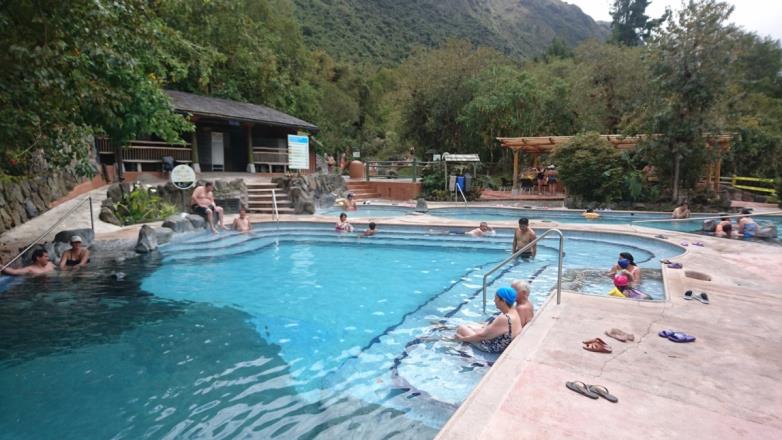
Thermal pools at Papallacta |
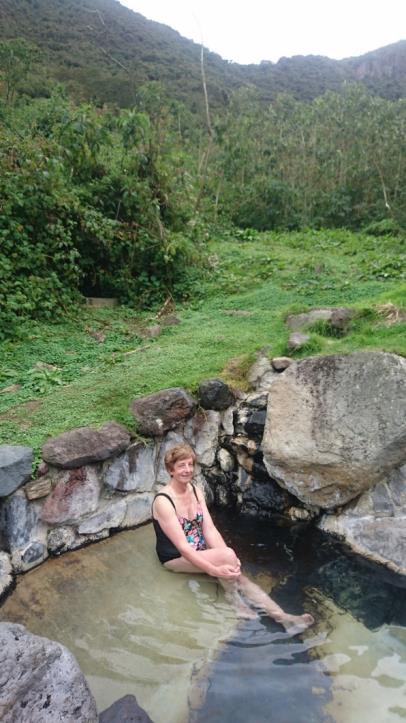 |
Quito Day 4
We spent some time packing and repacking cases ready for the flight to Peru – somehow Megan managed to get a different weight on the scales each time she tried! When we were ready to leave there was still a few hours till our flight check-in so we decided to look at the Museum Maria Augusta Urruta. This was the private home of a philanthropist widow which had been preserved as a snap-shot of privileged life in Quito in mid-20th century. Many pictures in the house were by Victor Mideras, a noted painter; – Maria was his patron. We had an included guided tour of the house in English.
After a coffee and cake in La Ronda we returned to the hotel, checked out and waited for a taxi. The trip to the airport was fast, thanks to a creative interpretation of speed limits. When we reached the departure gate, Adrian was called out for a random bag search (with four others) whilst Megan was in the toilets. Adrian was taken airside down by the tarmac to open cases for security to look inside. The rest of the flight to Lima was uneventful.
On arrival in Lima we checked into the Airport Hotel – an expensive option but very convenient for a stopover. They included a welcome Pisco Sour in the bar which was nice, but charged for bottled water which was unnecessary.
Part 2 – Southern Peru
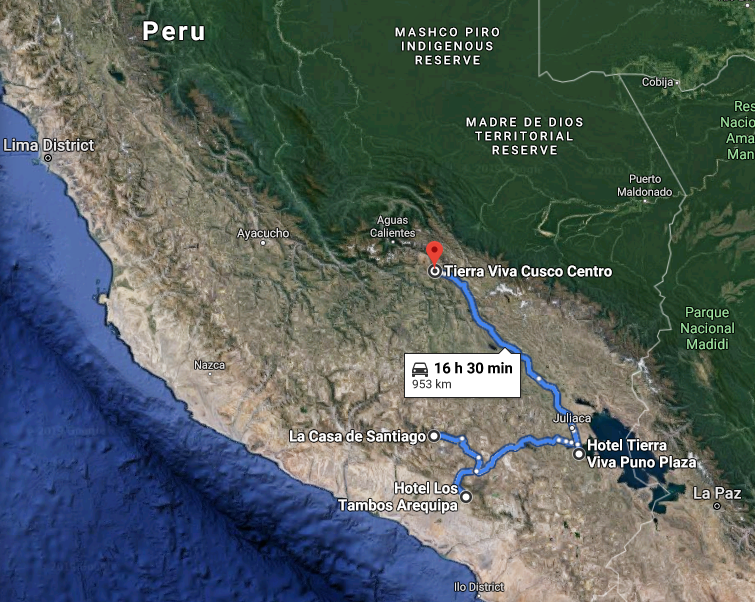
In the second part of our South American holiday we visited the south of Peru. This part of the holiday started by flying to Arequipa a Spanish city nestling at the foot of two volcanos. Our route then took us via the Coca Canyon to Puno on Lake Titicaca. A long coach trip took us to Cusco and the ruins of the Inca civilisation.
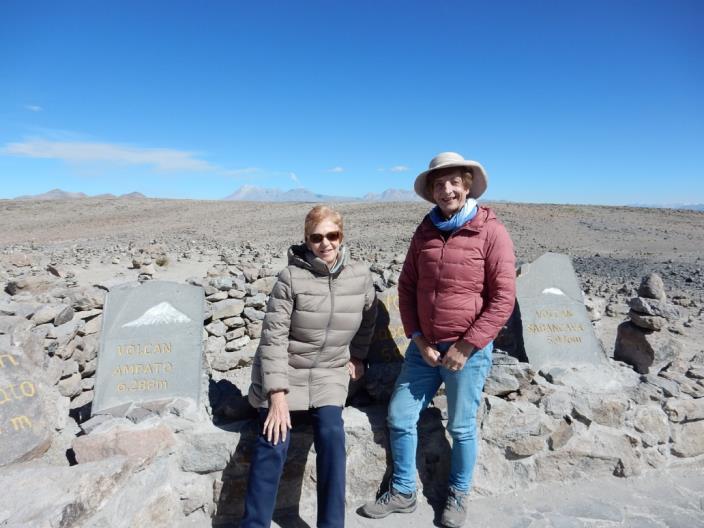
The highest point on our holiday 4910m
14th – 16th July
Heading South to Arequipa
Connecting flights in South America seemed to be a rarity, and getting from Quito in Ecuador down to Arequipa in the south of Peru was no exception. The airline schedules meant we had to stay overnight in Lima on the way. This had the advantage that we arrived in Arequipa late morning giving us an extra half day to look round the city.
Arequipa had an attractive colonial centre surrounded by non-descript dusty urban sprawl. At 2335m it was a similar elevation to Quito. Coca leaves were available in the hotel and they really did help one deal with the lethargy associated with low oxygen levels.
The undoubted highlight of visiting Arequipa was the Convent of Santa Catalina. This was very photogenic, but also gave a great insight into the life of well-off Spanish nuns.
Arequipa Day 1
The following day we continued our journey flying from Lima to Arequipa. Lima airport was chaotic. There was a long queue to bag drop and an even longer queue for security with a line that stretched through the food court. Lima airport is unusual because the international and domestic passengers were only separated at the security check. We made the delays even longer by joining the wrong queue. To cap it all in the departure lounge there was even a queue for the toilets! Luckily we had plenty of time having stayed overnight in the airport hotel. As we approached Arequipa there were spectacular views of the deep canyons. The airport was unusually solid, built in concrete like a bunker. It was a reminder that we were entering a very earthquake prone area.
The hotel had sent a driver to pick us up. He seemed less interested in driving safely and more in showing us pictures of food we could order in the city! The Los Tambos Hotel was very close to the Plaza de Armas and had a view over the city rooftops from the top floor. We had a “move by numbers” room with little space to lay out cases; the bathroom was marginally more commodious. We deferred unpacking in favour of heading out to get some lunch. As it was Sunday many shops were closed and the choice of food was limited.
Our search for tasty food took us to Crepísimo Creperie where we ordered some overpriced crepes. Then we spent the afternoon looking round the Convent of Santa Catalina. This cloistered community, founded in 1580 for rich Spanish nuns and their servants, occupies a large city block and was largely self-contained. The courtyards are visually very attractive with walls painted in deep pink and bright blue. Although the nuns accommodation was described as ‘cells’ they were in fact clusters of rooms including a kitchen and bedroom. In between the cells were winding laneways with glimpses up to the two volcanoes that tower over the city – Misti and Chachani. At the northern end of the convent was an ingenious laundry constructed from large amphorae cut in half. The small museum near the exit had excellent examples of religious art from the Cusco school (17th/18th century).
It took us a long time and a lot of walking to find a restaurant that evening that met our expectation of ‘reasonable prices’. In the end we discovered the perils of not eating off Tripadvisor recommendations – we ended up in a 2nd rate 1st floor restaurant behind the cathedral. Our waitress had a sour face which implied that any request was too much trouble! After sharing a starter of stuffed pepper Adrian braved a killer chilli ceviche whilst Megan chewed through a soup with rubber seafood. The only gastronomic highlight of the evening was that we discovered the Peruvian dark beer, Cusquena Negra, which was to be a favourite for the rest of the holiday.
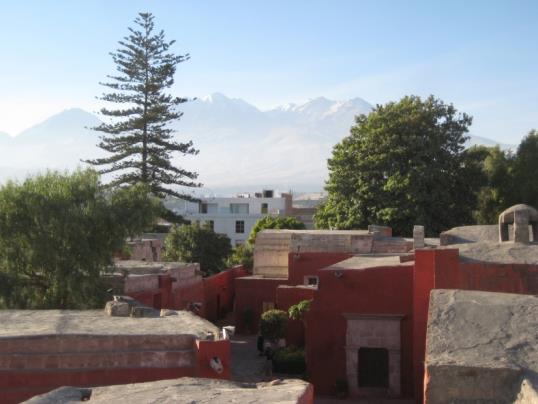
View from rooftop of Convent of Santa Catalina |
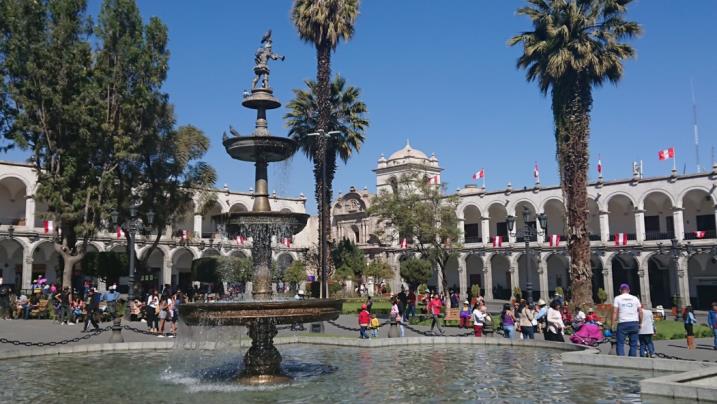
Arequipa Plaza de Armas |
Arequipa Day 2
You realise you are staying at high altitude when the ball in your roll-on deodorant pops out! Our hotel put on a very nice breakfast to order on the 4th floor – Adrian had pancakes! We rejected the idea of joining a free walking tour of the city as the interesting colonial centre was very compact. So we put together our own DIY walk.
Arequipa has many colonial churches, so we selected just one, the Iglesia de la Compania, to visit. It was dark inside, probably because the cloisters on one side had blocked some of the original windows. In the dim light the overly ornate gold plated altars looked quite drab. The cloisters next door had been sympathetically converted to shops – Adrian wandered into a few outlets looking for an Alpaca tunic but was frightened off by either the price or the lack of choice – clearly one size fits all for a Peruvian is a poor fit for an Australian. A ‘cake and coffee’ deal advertised in the window of a café across the road attracted our attention, and we both had oversized slabs of over-iced cake washed down with caffeine; all for $5.
Back on our sightseeing walk we poked our heads into Casa Rickets – a colonial house sensitively restored as a bank, which even included a free art gallery! Most of the colonial houses were built round an interior courtyard, so on several occasions we smiled at the security guard at the entrance and were waved through to look inside. Next to the Iglesia de San Francisco was an artisans market – Fundo El Fiero – where unsuccessfully Adrian continued a search for a jumper – but once you had looked at one stall it appeared you had seen everything available. All the overpriced shops offered “Baby Alpaca” – which we later learned referred not to the age of the donor animal but to the part of the body where the wool was taken from.
With the DIY tour finished we enjoyed a late lunch of toasted sandwiches washed down with a jug of fresh lemonade in Manolo’s (an unpretentious local restaurant). After another repack, to avoid using our big suitcase whilst on the road, we returned to the Plaza de Armas to see it all lit up after dark. The cathedral was open so we looked inside. It was rebuilt after an earthquake in the 19th century and was refreshingly free of gold leaf; the clean well illuminated interior was more to our taste.
Our guide from Pablo Tours turned up at the hotel for a briefing on time at 7pm. After she had explained details of the tour to the Colca valley and taken payment in clean American dollar bills, we returned again to the Plaza de Armas. We ate dinner upstairs on the plaza attracted by the offer of happy hour Pisco Sours. There were a lot of noisy demonstrations and marches protesting about a new copper mine the Peruvian government had approved.
16th – 17th July
Colca Canyon
The Colca Canyon 3270 meters deep belongs among the deepest canyons in the world. It is about 5 hours driving from Arequipa, but the route involves crossing a mountain pass at over 4900m. The young and fit trek to the bottom of the canyon, but we contented ourselves with visiting various viewpoints and taking short walks. The canyon is home to condors and we were lucky enough to see many of them in flight. The Colca Canyon is one of Peru’s most popular tourist attractions; but we booked a two day tour with an agent in Arequipa who specialises in avoiding the crowds. In that regard the trip was very successful. On the second day we didn’t return to Arequipa, but instead boarded a tourist coach to take us on to Puno.
Colca Canyon Day 1
Our guide turned up promptly at 6am, and after the hotel gave us breakfast bags, we jumped into a comfortable Land Cruiser for our trip to the Colca Canyon. The 4WD gave a comfortable ride on the rough roads. Climbing out of Arequipa we passed the vast Yura cement factory before circling round the Chachani volcano and entering the Reserva National de Salinas y Agua Blancas. Soon after entering the park we encountered Vicunas (the wild ancestor of the domesticated llama) grazing by the side of the road.
Our ‘Breakfast’ stop was at a clean new cafe just beyond the somewhat questionable truckers halt in Patahuasi. At 3963m it was time to have some Andean tea – a mixture of herbs (including Coca) to help with altitude sickness. On the walls of the café were some informative posters illustrating the different species of camelids. From the car park there were good views of the unusual volcanic rock formation called the stone forest.
The road to Chivay climbed steadily through the reserve with great views of volcanoes. The surface water eventually turned to ice, and we reached the top of the pass, the Mirador de Los Andes at 4910 m. This was the highest point we would get to on our entire holiday.
On the far side of the pass there was a very rapid descent of about 1300 m to the town of Chivay, nestling in the Rio Colca valley. After looking at the produce on sale in the local town market (and the local costumes) we drove a short distance down the north side of the valley to the village of Coporaque. After a lot of hard driving it was good to get out of the car and have some exercise. We walked on country laneways to a rocky outcrop where one could see ruins of a pre-Inca settlement and then back to the village. We were served lunch cooked by a local family but there was far too much food even with our guide and driver helping out. Whilst we were eating we watched Sabancaya volcano in the far distance ejecting pulsating plumes of ash.
In a change to the published itinerary we returned to Chivay to have a swim in the hot baths at a time when they were not visited by other tour groups. Though the baths weren’t as new as the ones we had visited in Ecuador they were well looked after. The murals on the lockers round the pools were most attractive. We had a large pool almost to ourselves for 45 minutes after which time the crowds arrived and we prepared to move on.
Our drive took us back over to the less travelled north side of the valley at Yanque. It was scary taking pictures of the old Cervantes Bridge from the road, as the new bridge had an unprotected drop either side of the roadway; definitely not a safe place for pedestrians. Travelling down the valley we saw more evidence of the destruction caused by the 2016 earthquake. There were still relief tents around, and most of the churches were damaged. Cracked walls were propped up with slender wooden poles, more I suspect to stop them crashing down on some unsuspecting passer-by than to provide strength in the next quake.
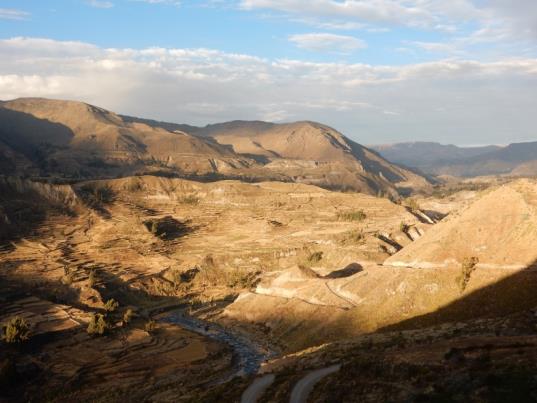
The Colca valley upstream from the canyon |
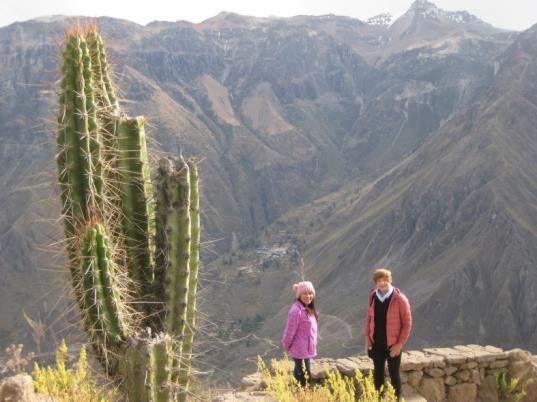
Mirador de Tapay overlooking the Canyon |
The villages had a grid pattern of roads but there seemed to be no idea of keeping a through road clear. Our driver had to explore the streets trying to avoid roads blocked by parked trucks and mounds of building materials. Even in a high clearance 4WD we had once to reverse out and try a new route.
As the valley got deeper we crossed over to the south side on the last bridge before the canyon and climbed up to the main road. After passing through a short tunnel we entered the Colca Canyon and lost sight of the river below. Soon afterwards we dropped down into the town of Cabanaconde perched on a ledge on the side of the canyon. We stayed overnight in La Casa de Santiago, a modern but simple hotel. As the temperature plummeted after sunset it was nice to have a warm room to retreat to. Dinner that night was a simple affair in the hotel which we followed with an early night. There was a weekend fiesta in the town and the fireworks went on till 4am. Luckily we were on the outskirts of the town so the explosions were somewhat muted.
Colca Canyon Day 2
Our itinerary promised a walk before breakfast to catch the sunrise over the canyon. There were two problems with this plan. Firstly it was a cloudy morning, and secondly the town had rounded up a number of wild bulls for their fiesta and corralled them on the path to the canyon lookout. We did have a walk in the dark – but to a view point on a hill near the town. We expected it to be cold but it was bitter with a biting wind blowing down the valley. However it was nice to watch and hear the town wake up as the day broke. As we walked back through the town we ran into a band playing; I wonder if they had gone to sleep after the fiesta the night before!
After one of the most basic breakfasts of the trip we drove to a roadside viewpoint (Mirador de Tapay) for the view down into the valley we had missed earlier. By the time we reached the main tourist lookout – the Cruz del Condor – we were not alone as other minibuses had already started to arrive. We were in luck because the condors were doing a fly past and we were able to have good look before they suddenly disappeared – just as the tourist coaches arrived! We had a good walk along the canyon edge to the next viewpoint, Cruz del Cura. The next view point Mirador Antahuilqe had a more open view of the pre-Inca terracing in the upper valley.
The main road to Chivay was much more geared up to tourism than the back roads we had used the day before. At the Mirador de Antawilqui there were stalls full of tourist tat. More interestingly there was a vendor selling Colca Sour which Adrian sampled. This was like a Pisco Sour but instead of lime juice it had the incredibly sour juice of the Sancoya cactus fruit.
Having had our swim in the thermal baths the day before, we were now running a bit ahead of time on the itinerary. We pretended to look round the tourist town of Maca and then wandered round Chivay for a bit. After dropping our bags at the bus depot we had a buffet lunch in a very touristy restaurant- Urinsaya. The food actually was quite good, and the bathrooms clean, so we shouldn’t complain!
Our coach to Puno arrived the depot at 1pm on time, but it didn’t have the WiFi (or on-board toilet) promised on the advertising signs. The seating was cramped, but as the bus was full there was no chance to spread out. The first part of the route to Puno involved retracing our route from Arequipa, passing the Mirador de Los Andes and stopping for a toilet break at Patahuasi. Then we headed east onto the altiplano with bleak grand scenery. As the light faded the weather took a turn for the worse starting as rain and then turning to snow. We had a quick stop to look at Andean pink flamingos in the far distance on a lake and then it turned dark. We skipped getting out of the bus for the toilet stop above Laguna Lagunillas – it was too cold and wet to queue in the dark. After another 2 ½ hours driving with no views out the window we reached Puno at 8pm – seven hours after we had left Chivay.
There was a thunderstorm just as we arrived in the centre of town, so it was lucky that our transfer included a taxi to the hotel. Even though it was only a couple of blocks away, we would have been soaked walking in the freezing rain. We had a modern spacious room in the Terra Viva hotel – complete with a kettle and free drinks in the bar fridge.
18th – 20th July
Puno and Lake Titicaca
Puno is an undistinguished town, but is the launching point for boat trips on Lake Titicaca. It was also the highest place we stayed in on our holiday. Although it was at 3827m we were by then well acclimatised and had no difficulty walking round the town or climbing the local hill. The highlight of our stay was a trip out to less heavily visited parts of Lake Titicaca. In particular we were fascinated the learn about the Quecha Indians on Taquile island, a society based on community collectivism and on the Inca moral code “do not steal, do not lie, do not be lazy”.
Puno Day 1
The itinerary gave us a rest day in Puno to acclimatise to the altitude. Our room overlooked a pedestrian street and on the opposite side was a branch of Banco de la Nation. Early in the morning, in the cold, queues developed outside our window and a security guard would regulate how many people were allowed inside. At times the queue would stretch round the corner for almost a block. Luckily the bank we used to withdraw money without fees (Scotiabank) never had a queue.
During the morning the overnight showers dried up and the sun came out but our portable thermometer said it was still only 4 degrees outside. We rugged up well and set out through the pedestrianised city centre to visit a travel agency to pay cash for our Lake Titicaca tour the next day. A military service was in full swing in the Cathedral complete with brass band so we poked our head inside.
From the Plaza de Armas it was about a kilometre walk to the port. As we got close there was a strange smell from the water; although Lake Titicaca was picturesque it was also quite polluted near the city. There wasn’t a lot of activity in the middle of the day at the port as most of the tourist boats had already left. Back in the city centre we visited a smart bakery (Ricos Pan) for lunch and had tasty empanadas. The combination of the altitude and a good walk meant we needed a siesta before tackling the walk up to Parque Huajsapata, on a hill behind the hotel. At the top of some steps was a statue of Inca Manco Capac and good views over the city and lake. At 3890m it was the highest walk we had ever done! We made a reservation for dinner at Balcones de Puna because it included a good performance of South American dancing – the food wasn’t too bad either.
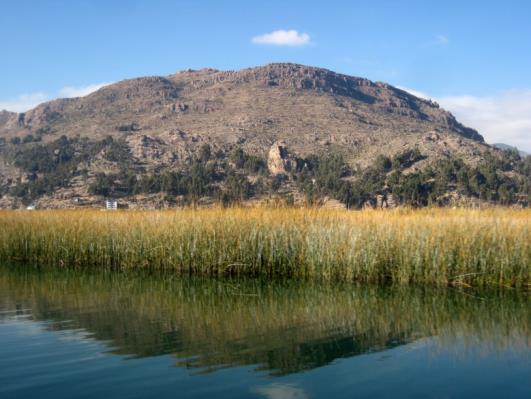 |
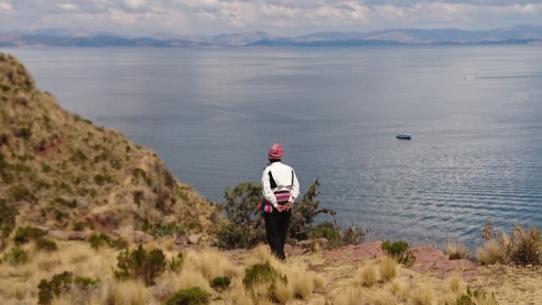
Lake Titicaca |
Puno Day 2
There was time for a quick breakfast before a 7am tour pickup. Actually we didn’t get picked up at the hotel because it was in a pedestrian zone. It was impossible to drive to it during the day, so we had to walk a short way to join a minibus full of passengers all going on the “Titicaca Uncovered” tour. To get out to the islands before the rest of the tourist crowd we had a fast boat which was comfortable and kept us out of the wind. The first stop was the furthest from Puno – Taquile Island home to Quechua Indians. A local family gave us an introduction to their culture. We observed the Spanish influence on dress and were shown the weaving traditions that identify marital status. The women weave and the men knit! It was interesting that the community had arranged marriages but the couple have to live together without children for a trial period before getting the actual wedding. The plants grown on the island reflected a micro-climate moderated by the lake.
We returned to the boat by a lovely sandy beach with sun umbrellas; but the water temperature would deter anyone from swimming! Leaving Taquile we headed back towards Puno stopping at the Peninsula de Capachica. Here a family prepared lunch for us the traditional way using food cooked in ground – a Pachamanca. The food was blessed by a junior Sharman before being dug out of the hot stone oven. The food was well cooked but it was all terribly dry without any gravy or sauces. We ate in a modern room which had I presume been built to attract tourism to the area.
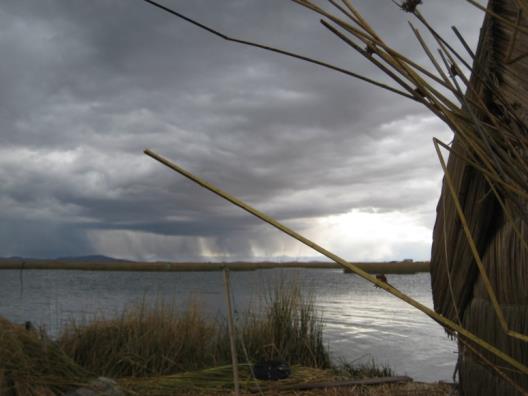
Storm over the floating Uros islands |
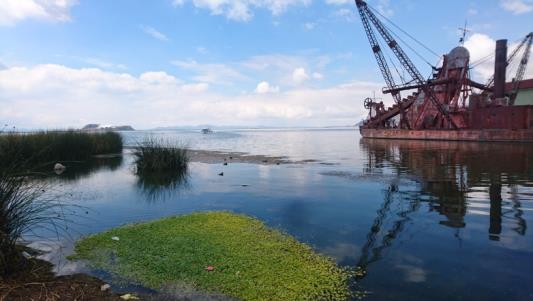
Puno Port |
Our final stop was one of the Uros floating islands. On the way there we dodged a massive thunderstorm cell which turned hills on the far shore white with fresh snow. Uros Titino was a very small island with perhaps three families; but at least they were still living there and not just boating out from the mainland to entertain tourists. We made our welcome party wait in the rain till it stopped so we could disembark in the dry. Walking on the sponge reed platform was most unusual, but living on it would be quite a health challenge. There wasn’t much to see or do on the island other than walk round on the bouncy reeds and avoid buying the goods on sale.In the evening we ate at Mojsa a busy comfortable restaurant on the main square. We kept the cold at bay drinking delicious hot wine and Adrian enjoyed Alpaca Cannelloni.
Puno Day 3
We elected to go from Puno to Cusco by the tourist coach which broke the long trip by stopping at interesting places on the way. The coach left at dawn so it was an early start for us. We grabbed breakfast drinks before taking a taxi to the modern Terminal Terestia. Inka Express had an efficient check-in, and after purchasing stamps for using the terminal we boarded a smart comfortable coach. This time the bus had a toilet and a soft drinks service after each stop (see inset).
The bus arrived in Cusco just as the sun was setting; we actually arrived at the same time as the train from Puno which had taken 11 hours for the same trip (with only one stop). After our experience in getting to the hotel when we arrived in Puno we had paid for a transfer in Cusco. The one way streets made for a somewhat circuitous journey to the Tierra Viva Cusco Centro which was conveniently located just on the edge of the historic centre. The suggestions from the hotel about where to eat were all far too upmarket for us, so we ate in a friendly pizza restaurant (La Divina Patricia) close by.
5 stops between Puno and Cusco
- Pucara for the pre-Inca history. This village was the location of the first urban centre in the altiplano from about 1800BC onwards. We looked round the small museum in the centre of the town which contained some interesting sculptures.
- La Raya for the views. At 4300m the highest point on the road from Puno to Cusco. From the pass we descended down the Urubamba valley most of the way to Cusco.
- Sicuani for lunch. This was a buffet meal in a smart modern building catering for tour groups. We had some very nice desserts including rice pudding. Underneath the restaurant there was a new Inca interpretive centre which provided context to what we were going to see in Cusco.
- Raqchi for an Inca Temple. This Inca archaeological site is dominated by the Temple to Wiracocha. It was an attempt by the conquering Incas to explain their invisible god to people who worshiped the sun and earth. The Spanish destroyed the temple but the centre wall is still standing built with stone foundations and an enhanced type of adobe perfected by the Incas.
- Andahuaylillas for the Jesuit church of San Pedro Apóstol (1570). Getting to the town centre was a challenge. When we turned off the main road the coach blocked the narrow street preventing traffic coming the other way from escaping. After a lot of arm waving we had to reverse out, go down the main road, turn round, and approach the laneway again. Second time lucky we made it up to the town square. Inside the church the walls and ceilings were covered in Jesuit murals which were largely covered over by later Dominican paintings. By the main door were graphic illustrations of heaven and hell to explain these concepts to the native Incan population. No photographs were allowed inside.
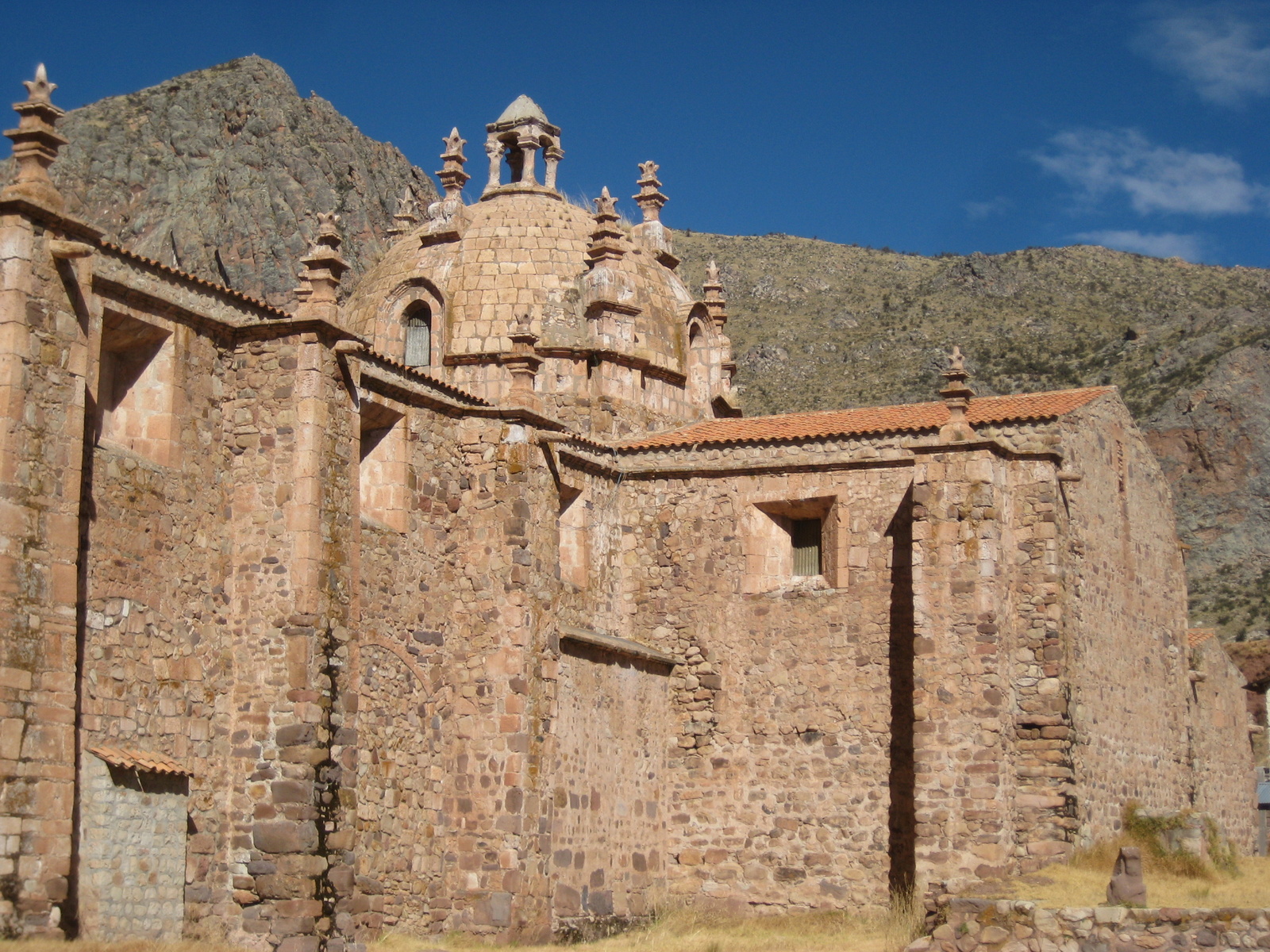 Pucara Church Pucara Church |
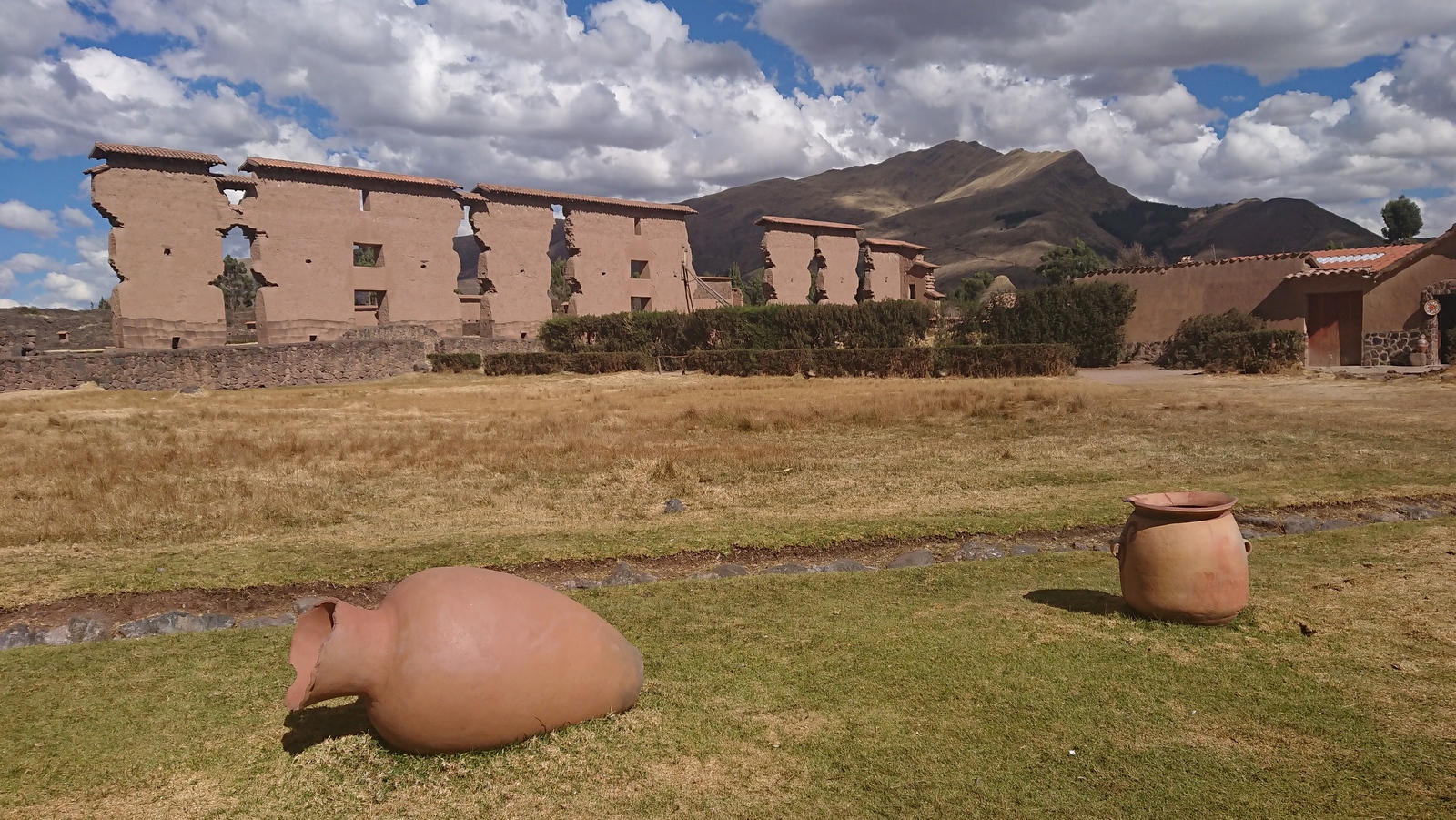 Raqchi – Inca temple to Wiracoch Raqchi – Inca temple to Wiracoch |
21th – 24th July
Cusco
The Inca city of Cusco was where we saw the most tourists on our trip. They were mostly there to visit Machu Pichu, but we decided to avoid the crush and focus on some lesser visited attractions. These included a visit to the Inca ruins of Pisac high up above the Sacred Valley, and the foundations of the Inca temple of Qorikancha. The much vaunted Inca stonework was indeed impressive, but it’s use was restricted to important temples and palaces. Most of the other stone work was no better than a Scottish crofter’s cottage.
Cusco Day 1
Once again we made our own walking tour of the city as the colonial centre was compact. Our tour started by walking down Loretto – a much photographed alleyway with Inca foundations on either side. We were prepared to be disappointed by Inca stonework but here this was not the case. The main square was large, but not as architecturally distinguished as the Plaza de Armas in Arequipa. We then had a ‘technical stop’ in our walk to get money from an ATM and buy our Boleto Turistico to the main historical sites. Actually we tried to buy the ticket first but found that the office only accepted cash. Back to sightseeing, we climbed up the narrow streets to the bohemian quarter of San Blas. On the way up we passed through Hatun Rumiyoc one of the best preserved Inca alleyways in the city. Plaza San Blas was attractive in the sunshine with its wide water feature and lack of cars. We made our way back down to the main square passing through Plaza Nazarenas and were then ready for some lunch.
A lot of the restaurants near the main plaza were expensive and had touts outside drumming up tourist trade. So we had to go further afield to find somewhere more in our price range. After a lot of searching we settled on Runas Garden Comida on Calle Plateros. It had the feel of a place that came alive at night with music and dancing, but they did have a lunch menu for $A7. Adrian tasted and enjoyed Lomo Saltado (stir fried beef) which is a Peruvian speciality.
We resumed our walking tour heading through Plaza Recocijo (with its trendy restaurants) to the tranquil Plaza San Francisco. There was no sign of the Quechua-speaking country folk that Lonely Planet claimed congregated in the plaza on a Sunday. We passed through a colonial archway into the bustling Mercado San Pedro. This was a particularly well organised market with clearly defined sections selling different things. Of particular interest was the juice section where rows of women offered freshly squeezed fruit and vegetable juices. It wasn’t clear why you would choose any particular stall as they all seemed to offer the same menu, so we opted for a young lady who had smiled nicely when we took a photograph!
For dinner we headed past Plaza San Francisco to the unusually decorated Chalca Resto Bar which combined an eclectic art gallery with a restaurant. It was full of young people with their rucksacks. Unfortunately on a Sunday night all they offered was a fixed ‘menu’ meal uninspiring but well cooked. The best bit, as with lunch, was the soup.
Cusco Day 2
To visit Pisac in the Sacred Valley we had arranged with the hotel for a private car. It wasn’t a cheap option but gave us flexibility to go where and when we wanted. Our route to the Sacred Valley climbed out of the old city past the Inca sites of Saqsaywaman and Puka Pukara then dropped down into a broad valley. This is where the controversial new Machu Pichu airport is to be built. From that valley a narrow defile cut through to the Urubamba River which was a lot lower down. From the mirador above Pisac there was an impressive view over the valley to the snow covered mountains beyond.
The historical site of Pisac was accessed by passing through the town and then climbing up a winding road up a side valley. Extensive Inca terraces covered the steep hillside above us. We were able to park close to the site entrance as the narrow car park was quite empty. With military, religious, and agricultural structures, Pisac served at least three purposes. The ruins are separated along the ridge into four groups, but we were unable to visit the temple complex as the path cut into the cliff was closed for repair.
We looked round the military compound near the entrance, the ceremonial area with its baths, and the citadel of Q’allaqasa. The warren of rooms in the citadel built on a steep sided ridge was great fun to climb around and explore. Across a small stream was a sizable Inca burial area but it was a long time before we spotted the small caves in the hillside. Because we couldn’t take the direct cliff route to the temple complex we took a lower path which then climbed back up to the Pisaqa residential area perched on a ridge. By now we were pretty exhausted after 2 ½ hours clambering at altitude, so we skipped the final ascent up to the temple area and headed back to our car.
We were back in Cusco in time for a late lunch in a café followed by a look round the large, but chaotic Inca Museum. Perhaps the museum wasn’t seen at its best because we managed to go round the second floor in the wrong direction! In the courtyard there were a couple of women sitting at native looms. We were interested to see how the different patterns were created as the warp threads are coloured and the weft plain. But after watching for a while we realised the ‘weavers’ were faking it and not actually weaving!
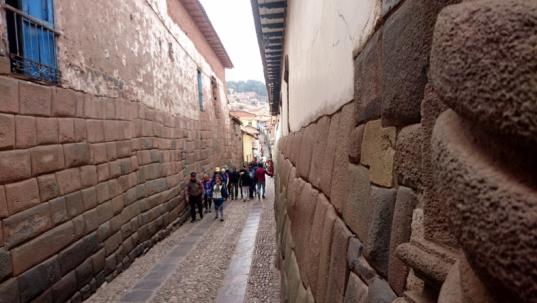
Hatun Rimiyoc alleyway leading up to San Blas |
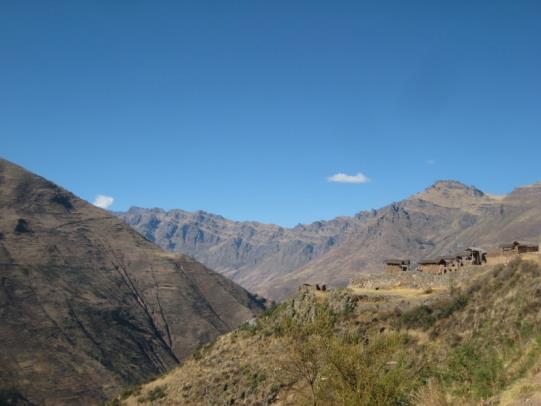
Pisac: Inca ruins |
Cusco Day 3
We woke to drizzle and conflicting weather forecasts so we downgraded our plans for the day. We decided to start with a museum visit and see what happened to the weather. The remains of Qorikancha, the most important Inca temple, are a must see. A Dominican church and cloisters were built on top of the old temple but a lot of high quality Inca stonework remains in the foundations. Over time the Spanish construction has repeatedly collapsed in earthquakes, most recently in 1950. It was after that most recent quake that the Inca foundations were uncovered and left that way. We first looked inside the rebuilt Dominican church of Santo Domingo (free entry) and were surprised to see how effective the dark wood altars were with sensitive lighting. Entry to the museum to see the Inca stonework cost S/15 which was good value. Where the cloisters had been removed (thanks to the earthquake) you could look at quite impressive remains of the Inca buildings. There were lots of nice surprises as we wandered round, including finding an upstairs access into the choir balcony of the church next door.
When we exited from Qorikancha the clouds had gone and we activated our provisional plan to climb up to the Inca ruins above the town. We had a coffee and cake in the San Blas district above the main square then carried on climbing up steps out of the colonial centre and into an area of simple modern housing.
Using Google to direct us we took a route up to the Q’enco Archaeological Complex which took us up away from the main road and up a residential street. When we reckoned we were close enough we took a rough short cut and scrambled to emerge at the back of the site. By missing the main road we bypassed the ticket collector but didn’t feel guilty as we did have a ticket. Q’enco is a huanca (Inca holy place) based on a naturally occurring rock formation. It was believed to be a place where sacrifices and mummification took place. Unfortunately there was no access to the top of the rock to see the channels used to collect blood from sacrifices, but the cave and tunnel underneath were fun to explore.
It was a level walk from Q’enco to the walled complex of Sacsayhuaman (pronounced Sexywoman). After showing our tickets to the guard we passed the sacred spring Calispucyo and found a quiet area of grass to rest and eat our picnic lunch (mostly sourced from the breakfast buffet). Walking round the outcrop of volcanic diorite we looked over a vast flat area of grass to the substantial remains of the Inca fortress walls. The stones in the walls were so large the Spanish invaders left them, but they effectively raised to the ground all the buildings within.
When we had explored the site we took the direct path down to the city which dropped rapidly down a narrow gulley by the side of a rushing stream. At the bottom we came to the church of San Cristobel with good views over the colonial city. From there we followed narrow steep cobbled streets down to the main square.
On our final evening we celebrated by eating at a smart but not over-expensive restaurant just off the main square. Restaurant Sumaqcha came highly recommended on TripAdvisor, and we enjoyed some quality local cuisine. We started by sharing a local speciality rocoto relleno cusqueno. This was like the stuffed peppers of Arequipa except it had a coating of batter and had been fried – delicious!
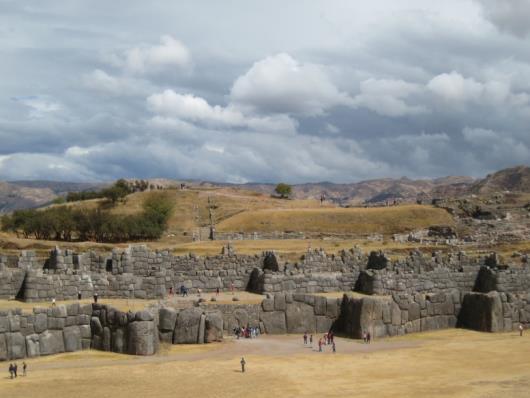
Cusco: Sacsayhuama |
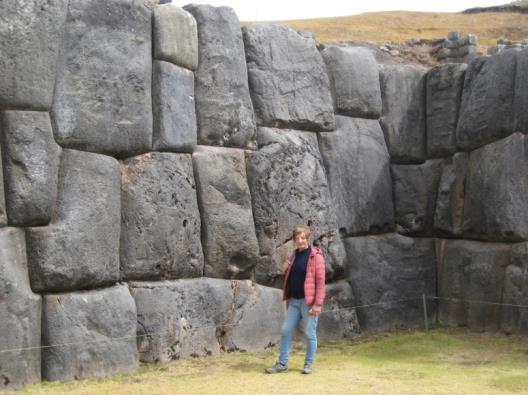
Cusco: Sacsayhuaman Inca walls |
Cusco Day 4
All we had to do on our final day in Cusco was to get to the airport in time for a 10:30 flight to Lima. Pretty easy as Cusco airport is still in the middle of the city! But the airport itself was chaotic. After bag drop and security there was a small departure area where we found a couple of seats and prepared to wait for over an hour. In a first for us, we succeeded in actually missing the flight even though we were in the departure lounge! We had to rebook on a later flight (see inset).
The delay to our arrival in Lima was made complicated because we had arranged for a transfer to the hotel. Whilst we were waiting for our later flight Adrian tried desperately to send a message to the lady picking us up. In the end an expensive phone call was made to ensure everything was ok.
How to miss a flight at Cusco Airport
So there we were sitting in a small departure lounge some way from the advertised departure gate. The indicator board only showed each flight as Confirmed. There was no status change to show Boarding. Occasionally Adrian would get up and look for any signs of activity at the gate but there was none. About 30 minutes before the scheduled departure we thought we should join the queue that was developing at the gate. But then the indicator boards changed and it turned out we were joining the queue for another airline and flight! Panic!
After Adrian quizzed a number of staff (in Spanish) it was clear we had actually missed the flight. We had to go back through the security screening and talk to someone in the check-in hall. They succeeded in recalling our bags so we could re-check them onto another flight. And after paying US$40 each we returned to the gate with tickets for a flight leaving in 45 minutes.
This time we didn’t sit down, and instead stood at the gate advertised for our new flight. We weren’t going to make the same mistake twice. So imagine our surprise when people started to walk away from the gate to another one even though the monitors hadn’t changed. Then there were announcements in Spanish and everyone moved across to the ‘wrong’ gate. A nice lady pointed out that we were “old” and so were entitled to join the shorter queue for those needing assistance – so we hobbled over to join her!
Eventually the monitors changed to show we were at the correct gate! After waiting in the bus we boarded and then still had to wait half an hour on the tarmac to take off. The final insult was that there was no food left on the flight so we missed out on lunch!
Lima was ramping up to hosting the Pan-American Games that weekend and so the airport was busy. But they had put on extra staff and things were running smoothly. Our patient driver was still waiting for us, and within an hour we were checking-in at the Hotel Continental, our base in Lima for the next couple of nights.
Having been warned that Lima was not a particularly safe city we didn’t explore too far from the hotel. There was a security guard outside the front door, and after dark the door was bolted from the inside. We celebrated our safe, albeit late, arrival in Lima with a couple of craft beers in a bar near the hotel, followed by our first delicious taste of ceviche in Chita Loca, a bright modern cebicheria next to the hotel.
Part 3 – Northern Peru
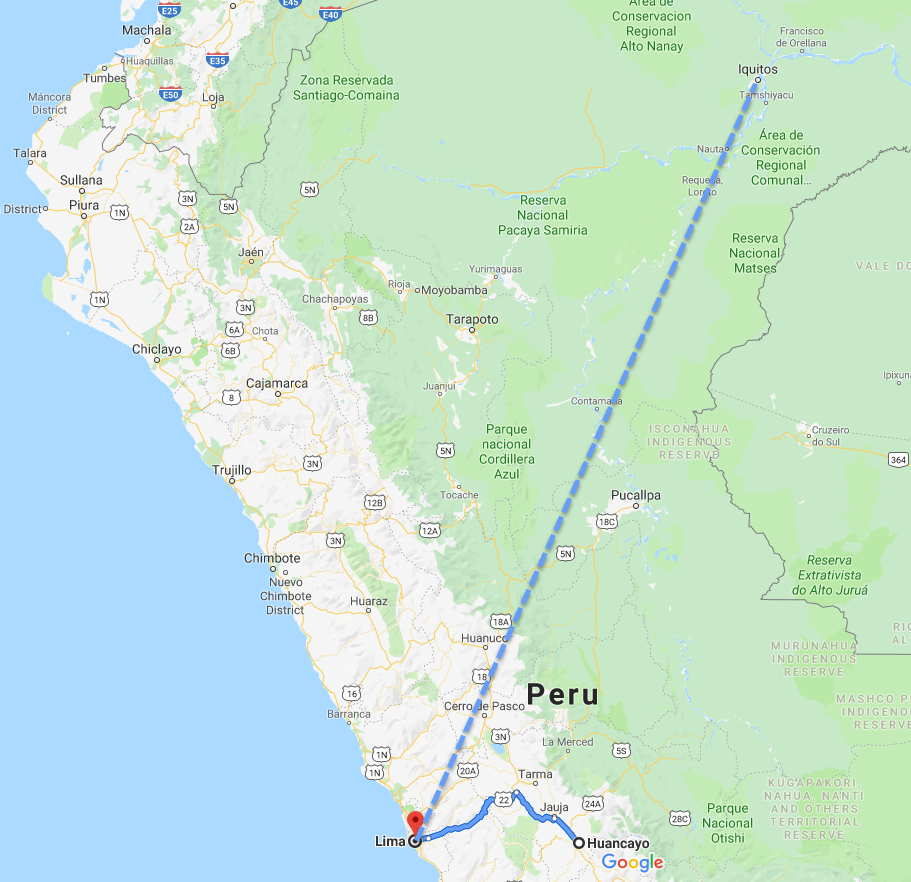
For the final part of our holiday we returned to Lima. Besides looking round the city where a third of the people in Peru live, we took two side trips. The first trip was by train to Huancayo a city high in the central Andean valley relatively untouched by tourism. After a weekend celebrating Peruvian Independence Day with the locals we returned to Lima and took a second trip by plane to Iquitos deep in the Amazon jungle.
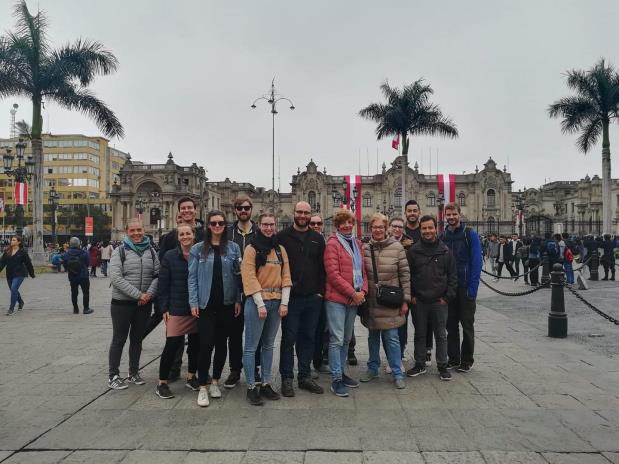
25th July
Lima
The capital city of Peru is dusty, foggy, sprawling, ugly, dangerous and generally not high on the tourist agenda. But as it is the hub for transportation in the country we had to stay there twice between different legs of our holiday. We stayed in the old colonial centre, an area not popular with tourists, but which had the convenience of easy access to the train station and airport. The main attraction of Lima for us is that it is the home of ceviche, raw fish ‘cooked’ in lemon juice. This dish was so seriously good that one ignored any health risks associated with uncooked food.
Lima Day 1
Our hotel in Lima had a somewhat dated feel, though our room was comfortable and high enough up to not be troubled by street noise. The bathroom had been modernised at some time with the bath replaced by a shower and 3 modern downlights over the basin; but we gave up on getting all three lights to illuminate at once! The view from our window looking north over the colonial centre was very unspectacular. The foyer had a high ceilinged lounge area which was very dark, but the restaurant for breakfast was bright as it had once been open to the street.
The breakfast buffet included Agua de Una de Gato to drink, which Google translated as Cat’s Water (it was actually an extract from some plant). The hotel was conveniently close to a large Metro supermarket so we headed there to buy food to eat the next day on the train to Huancayo. The shop seemed to sell everything a household would need – even selling car tyres next to the self-service salad bar. As we wandered round Megan spotted magnifying mirrors so Adrian was able to replace the one left in a previous hotel bathroom. Another interesting innovation was that there was a checkout specifically for seniors and disabled shoppers. The Caja Preferencial had seats to sit on whilst waiting. We didn’t use that lane!
After a late lunch we headed back towards the river and joined a tour round San Francisco church. The highlights were the library (with 25,000 ancient texts) and the catacombs (where 70,000 people were estimated to be buried). The tour was very rushed and gave little time to appreciate the many fine paintings by the school of Francisco de Zurbarán and Rubens. Back at the hotel and tired from walking we repacked so that we would only have to take our two carry-on cases on the train for a weekend in Huancayo. For dinner we visited one of the better Ceviche restaurants, La Muralla, off the east side of Plaza San Martin. The ceviche was very artistically presented and the waiter was very good. He even recommended us against finishing our meal with a hot chocolate as it might not go well with the acidity of the fish. Whilst we were eating, a large angry demonstration went past closely monitored by riot police. We took a different route back to the hotel to avoid the noisy crowds in the Plaza.
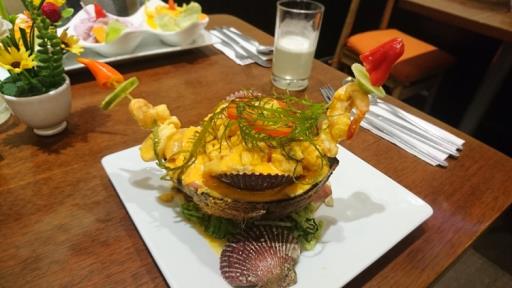
Ceviche |
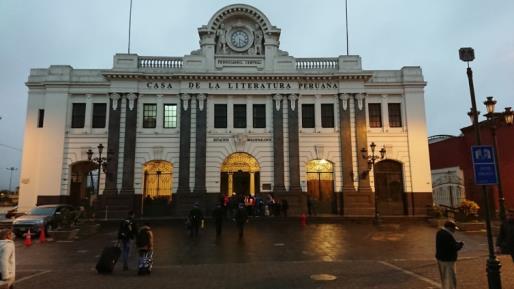
Lima Railway Station |
Lima Free Walking Tour by Inkan Milky Way Tours
At 11am we met up outside the La Merced church for a free walking tour. It was surprising to see vultures living high up on the church in the middle of the city. Our tour guide was Richard and he was excellent – he even had a mini-PA with him so he could be easily heard over the city noise. To start the tour he took us inside the beautiful house that belonged to the hero of South American independence; Bernardo O’Higgins. Bernardo liberated Chile from the Spanish. Casa O’Higgins is now a small museum. When we visited there was a display of the costumes used in the highland Quyllurit’I festival.
We watched the changing of the guard outside the Presidential Palace waiting for anything to actually happen, but it appeared to be an exercise in slow motion choreography. Without waiting for the climax we crossed over the railway and the heavily polluted Rimac River to see the smallest church in Peru; with a lingerie store next door!
When we headed back to the Plaza de Armas our way was blocked by riot police. Apparently the government had shut down the square to thwart a plan for a demonstration march. The closure made it very difficult to visit all the remaining sights on the tour. We looked inside the church of Santa Domingo which had a side altar dedicated to Peruvian saints. Under the statues there were reliquaries, one of which had a window showing the skull inside. A long diversion round the cordoned off streets took us to the river on the other side of the Presidential palace. Here was the Casa de la Literatura, a library occupying the old Desamparados Station. This was where we would catch the train to Huancayo the next day.
The final stop on the tour was a set of lunch recommendations. We took the desayuno ‘menu’ with free pisco sour! It even included a desert.
26th – 29th July
To Huancayo on the Ferrocarril Central Andino
The train from Lime to the high Andes has to be one of the most exciting and little known about train journeys in the world. To reach the summit level of 4751m was a tremendous feet of engineering. There is only one passenger train on the line each month, and our entire holiday was designed to ensure we could make the July departure. This round trip coincided with Peruvian Independence Day and our weekend was shared with Peruvian holidaymakers so had a happy party atmosphere.
Because of the logistical difficulties getting there the Central Andean valley is rarely visited by tourists. This meant that when we visited on a festival weekend we were able to experience traditional celebrations and get an insight into how the Huanca people lived.
Huancayo Day 1
With the city centre still in lock-down there was no chance to take a taxi to Desamparados Station. So at 6am we set out walking on the dark streets wheeling our two carry-ons behind us. It was always a slight concern that we didn’t actually know how the train would board given there were no platforms and the station was now a library. But as we passed the Cathedral we could see the old station ahead of us glowing in the dark. It turned out they opened up the station building just so we could get access to the train.
We settled ourselves into our allocated seats in the second Tourist coach. With daylight came a typical grey sunless day in Lima. But it wasn’t long before we climbed above the sea mist and from then on we had clear blue skies that were perfect for photography. Initially the observation car at the back of the train was packed, but soon the temperature dropped and people moved inside to the bar or back to their coaches.
There was a doctor and a nurse on-board and when the train passed through 4000m they were busy helping passengers. We did note that those who had been the most conspicuous in the bar at the start seemed to be the sickest at altitude. We saved up having our complimentary pisco sour till we were well on our way down from the summit. Each carriage also had a “hostess” whose main task was to serve breakfast and lunch from repurposed airline trollies. There were also several security guards on board who seemed to be enjoying a weekend away rather than providing any real protection to the passengers.
The trip to Huancayo was shared with a TV film crew so we all ended up being ‘extras’ in their documentary. ‘Ten Take’ Teddy was the presenter for the Discovery Chanel show “Mighty Trains”. There were two camera crews wandering round the small train. Often they would have to ask other passengers to move so they could get the shot they wanted, but the inconvenience was more than made up for my the interest of seeing them at work filming.
After San Bartolome station two dancers joined the train and they gave a number of performances in the observation car – generally when the train was halted and not lurching from side to side. As the train climbed it became very cold outside and the open observation car emptied. Adrian stayed outside to capture photos of the mountains.
Just after 2pm we reached the long summit tunnel. Megan missed this moment as she was plunged into darkness, caught with her pants down in the toilet. The tunnel was followed by a long stop at Galera station for everyone to take pictures.
When it got dark there was a party in the observation car (organised by the TV crew I suspect) with free drinks, dancing and general public holiday weekend merriment. One group was playing the card game we call “Uno” in Australia – except in Peru it was “Dos”!!
After 12 hours (and after dark) the train crawled into Huancayo station. Actually it arrived twice as the train was too long for the platform. When everyone was off the train there was a scrum as the passengers tried to claim their luggage through a narrow doorway.
Lucho, our local travel agent was outside the station gates to meet us and transfer us the short distance to our hotel. It was clear from his emails that Lucho was something of a character, and this was borne out when we met him; he was a 60+ year old eccentric opinionated long grey-haired hippie – and most likeable! We hadn’t eaten, so after the check-in formalities at the hotel we headed straight out to Lucio’s pizza restaurant for dinner. This was an eclectic establishment (reflecting the eccentricity of the owner). The room was crowded with a selection of antique jute boxes, valve radios, blow torches and old refrigerators. The kitchen produced a delicious pizza for us washed down with our favourite Cerveza Negro.
We had an interior room in the Hotel B&V which means we weren’t troubled by street noise. However the hotel had reverberating corridors that echoed like a prison when someone slammed their door. Our room was particularly safe. Buildings in Peru had clearly labelled places that were safe to be in case of an earthquake, generally by a modern concrete pillar and roof beam. In the Hotel B&V we were on the 6th floor but had a safe zone actually in our room, by Megan’s bed! The hotel had a lot of light wells (for the interior rooms like ours) but as a result it cooled down quickly at night.
By train to Huancayo
The railway between Lima and Huancayo took nearly 40 years to build and was finished in 1909. To climb up from sea level to the summit tunnel at 4751m the railway has 9 zigzags (switchbacks) 71 tunnels and 68 bridges. It carries heavy mineral traffic from mines high up in the Andes and is maintained to a very high level. But the passenger service is limited to a few round trips a year.
Leaving Lima’s Desamparados Station the engine horn blared continuously as the train edged its way through some depressing dusty suburbs with lots of road crossings. When the train reached the main engineering works at Chosica a few more passengers got on and the 4 tourist cars filled up. The dusty suburbs were swapped for a much more interesting narrow valley. As the river started to climb the train found it couldn’t keep up, so at San Bartolome it had to backtrack to gain some more height. This first switch is the only one that is not part of a pair of zigzags so it results in the train going backwards. Because of this the engine had to be decoupled, turned round manually on a turntable and reattached to the new front of the train. This also put the observation car at the back of the train where it belonged.
After taking a scenic loop through a couple of side valleys the train resumed its climb, now some way up from the valley bottom. Thirty kilometres later the railway was once again level with the tumbling stream and needed to gain height with a succession of zigzags. The first switch at Tambo de Viso was in such a narrow valley that there was a dead-end tunnel for the train to pull into so that the points could be switched.
Even the main road now started to climb with hairpin bends, and a second zig zag took the train to San Mateo at 3,300m. Shortly after this the train entered a narrow defile where there was barely room for the road. The railway dived into a tunnel, exited over the Inferno Bridge high above the stream, and then dived into another tunnel. This section of the line was notoriously difficult to construct.
At Chicla the railway took the longest zigzag which involved reversing up the valley, and then down the other side before returning to normal operation at the upper points. As the train travelled backwards to the upper points a guard stood at the back of the train in the observation car. He would talk to the engine driver on his radio, and had an emergency brake so he could stop the train if necessary. In fact it was necessary above Chicla when we reversed round a tight bend to find a donkey standing on the tracks!
The train was now above 4000m where the hillsides became barren, scarred by all the mining operations. There was frost and ice by the railway side. After another two zigzags the train reached the summit and Galera station on the other side.
The train stopped at Galera for a thorough check before starting the descent down into the Central Andean valley. With a single zig-zag the line dropped into a broad valley past large tailings dams associated with copper mines. The railway’s route was straightforward, gently following the valley downhill. Soon the train pulled into La Oroya station, in a town dominated by a huge smelter. From La Oroya the railway entered the lush Mantaro Valley which it followed gently down to Huancayo (3245m). The station in Huancayo was in the middle of town; the train created a large traffic jam because when it stopped it blocked the main road.
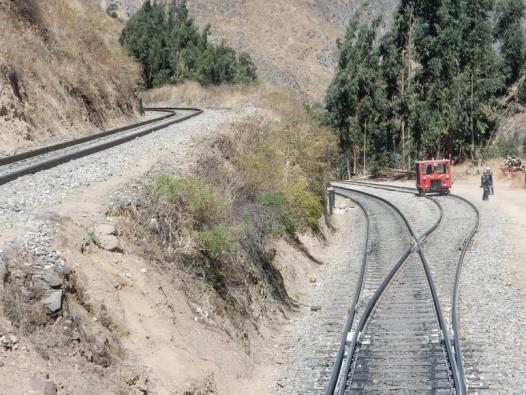
One of the 9 switchbacks on the way to Huancayo |
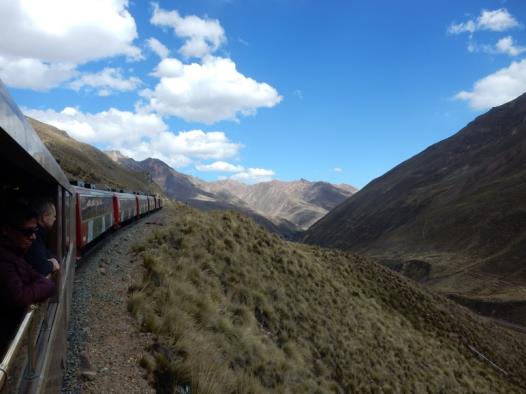
Ascending to the summit |
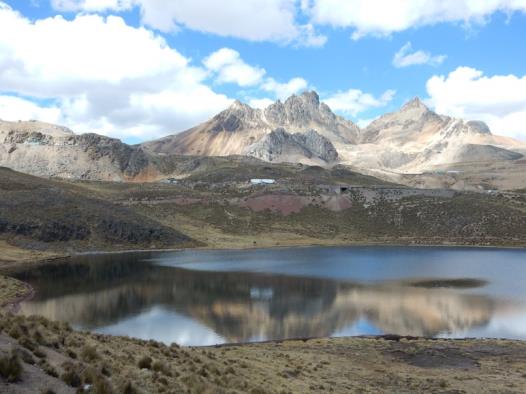
One Laguna Tictcocha |
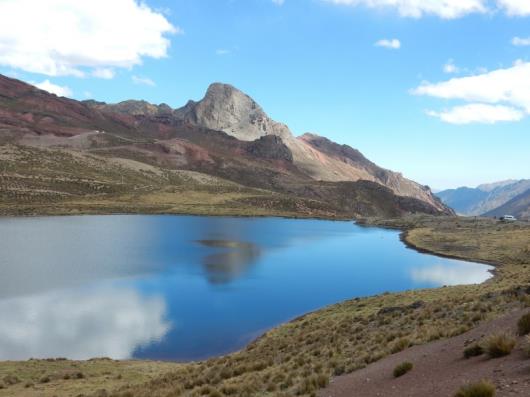
Laguna Tictcocha |
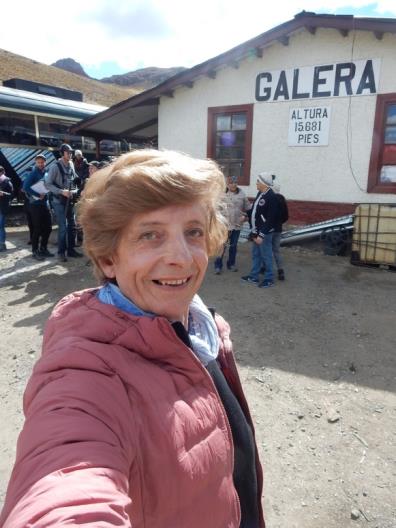
At the summit |
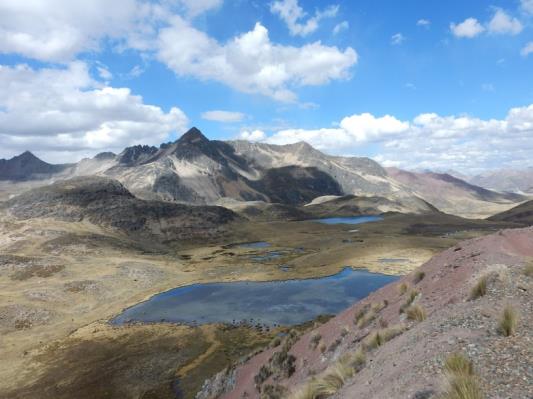
Descending down into the Mantaro Valley |
Huancayo Day 2
The hotel served up a reasonable breakfast with hotcakes for a change. Our guide Lucho was waiting for us at 9 with his young protégé Eric driving a taxi. The day started with a short trip to Chupaca where there was a live meat market on Saturday. This was quite a confrontational place to visit and we felt that perhaps Lucio was checking us out to see what we were up for; we launched into going round the market with enthusiasm. The market was just some rough ground where farmers and purchasers parked their trucks and did business. In the sheep section every part of the animal was used. We had never seen such a graphic demonstration of how meat is processed; with sheep being shorn, gutted, and heads blackened with a blow torch to make soup. Round the edge of the market were stalls selling meat dishes from animals that were alive only an hour or so earlier. A second part of the market processed pigs, which were checked for disease under their tongue before being sold (cysticercosis is endemic in the area). The part of the market selling cows and horses was much less interesting.
Eric drove us to the centre of the town where we wandered round the sprawling local market selling everything from traditional dancing skirts to live chickens. It was interesting to see soldiers in fatigues walking through the market selling a newspaper to support their preferred presidential candidate. To celebrate the Independence Day weekend there was a food fair serving the festival dish of Lechon. On one side of the street there were stalls selling roast pork, and bread buns on the other, and coffee stalls with tables and chairs where you could sit and eat your meat sandwich. It was obviously special because Luchio bought some Lechon to eat later.
Heading west we got out of the car close to the Laguna de Nahuinpuquito, and climbed up a hill on a long path to the archaeological site of Arwaturo. There was a good view over the Mantaro valley from the 27 ruined colcas used for storing grain. We returned to Chupaca to the Restaurante Campestre El Mollecito where we had our second Pachamanca lunch of the holiday. It was only barely more edible than the first – because some of the dishes at our request were barbequed rather than baked in the ground. Lucio ordered a plate of oven-dried mixed meats but luckily when we hesitated the driver took the cuy (guinea pig)saving us having to refuse it .
After lunch we drove south to Chongos which was having a big celebration coinciding with Independence Day weekend. There were marching groups from various communities featuring black men with whips, girls dressed in brightly coloured traditional skirts, and noisy brass bands. Each group delivered gifts of fruit and beer to some local dignitary. Outside the church there were people burning candles round a cross and waiting for them to burn. The resulting wax patterns were taken to be read. The old church was one of the first built by the Spanish in Peru. It dates from 1565 and was very austere inside.
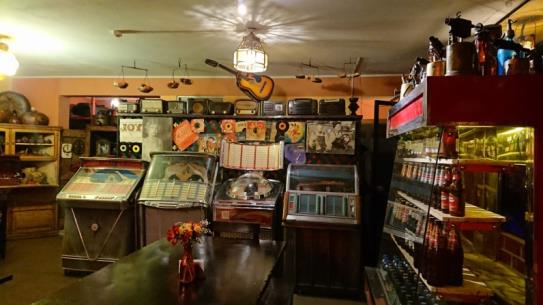
Huancayo: La Cabaña Restaurant |
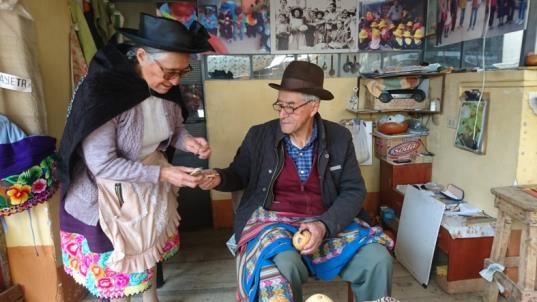
Conchas: Gourd Carving |
In the evening, we walked to the main square of Huancaya down narrow streets with even narrower footpaths peppered with holes. Behind the cathedral was a busy restaurant, Detras de la Cathedral. Adrian tried Tacu tacu whilst Megan enjoyed a tasty soup. We rounded the meal off with hot chocolate which was deliciously rich but not sweet.
Huancayo Day 3
Our planned train trip to Huancavelica on Sunday couldn’t happen as the railway line had been closed for ‘improvements’. Lucho was most sceptical about the motives behind the new owners of the railway.
It was Peru National Independence Day and most villages were celebrating in some way. We started our day’s sightseeing (with a different taxi) by visiting Parque de la Identidad Huanca. This park was designed by a Spanish architect in the style of Gaudi, and built in 1992 at a low spot in city life after the civil war. Huancayo was on the font –line of the fight against the “shining Path” movement and suffered greatly in those years – there certainly was no tourism till this century. For an English speaker there were plenty of titters about the name of the local people – Wanka. There were even Wanka taxis!
Leaving Hunacayo we explored the traditional crafts in villages on the eastern side of the Mantaro valley. The first stop was Conchas, a town famed for its gourd carving. We were surprised to see what skilled artistic work went into the creation of a carved gourd. An old man demonstrated how the gourd can be coloured with a glowing stick or the pattern highlighted by ash. We gave the elderly couple a donation as Australian restrictions wouldn’t allow us to take a gourd home. On the outside of town we popped in unannounced to one of Lucho’s friends. Kuskalla was grandiosely named as a “Centro Ecologico Cultural” but in reality was a delightful rural retreat. We had coffee sitting on comfortable chairs looking down into the wooded valley.
To get to the next town on our itinerary Lucho directed the taxi down a set of very rough dirt roads. It turned out that these were the tracks he used when cycling! Our taxi was hardly 4WD, in fact it had trouble getting over the speed bumps on the roads let alone a dirt track. We stopped in the centre of Hualhuas to see its local speciality – weaving, and then in San Jeronimo where the cottage industry is silver filigree. The market street was lined with shops selling silver jewellery. The prices were very reasonable, but we came away not buying anything.
Heading further up the valley we passed through Conception to a family farm turned into restaurant, owned once again by another of Lucho’s friends. After a lifetime as a travel guide in the area he had a lot of contacts, but they like him were now getting old. Eating outside in the shade we sampled the speciality of Recreo Los Manantialesto – trout; the garlic trout in particular was delicious. Lunch was a leisurely affair including a tour round the farm, which came complete with a collection of rusting antique cars. It was mid-afternoon before we set off to drive back to Huancayo.
Because it was Sunday and a public holiday we didn’t trust our chances of finding any restaurants open. We took an easy option, eating in an American-style restaurant in a smart new shopping centre close to our hotel.
Huancayo Day 3
We were up early on Monday morning, ready to wheel our carry-on down the main road to the railway station. The train was there waiting for us, but they had to move it so that passengers could get to all the carriages. With the train half out of the station it blocked the main road, which made it very popular with Monday morning rush hour.
All the same passengers were on the train and they were generally in high spirits after a holiday weekend away. We were also re-joined by the TV crew.
As the train started to get going, climbing up the valley, it suddenly came to a halt. There was a tree on the track which had to be cut up with chain saws before we could continue. At Tambo the engine reversed round the carriages using a Wye placing the observation car correctly at the back of the train.
Passing Jouja the valley became much narrower and seeing it for the first time by daylight we were able to appreciate the unusual rock formations and colours. From the mining town of La Oroya onwards the trip was essentially a reverse of our trip up on Friday. The weather was cloudy so the photography wasn’t as stunning, we weren’t issued with free pisco-sours, and we didn’t get time for a walk-about when the train stopped.
By the time we got back down to the train depot at Chosica the visibility had dropped and everything had turned to the Lima dusty grey. As the sun set we inched our way through the suburbs of Lima now lit by street lights. Then just as we were planning what we were going to do when we arrived at the station, the train stopped…and we waited for it to move again. We were on a single track, with no signals, and it was clear by peering round the engine that ahead of us were the headlights of another train coming towards us! We had to wait nearly an hour whilst they found another locomotive to pull the freight train back to a passing loop, and then we were free to continue our run into Desamparados Station.
When we got off the train there was a repeat of the scrum to collect luggage, this time enhanced by it being dark and raining. It was now late and we hadn’t had dinner, so eating was our priority rather than checking in to the hotel. We headed for the casual ceviche restaurant next to the hotel but that was closed so we had to try Plan B. Dumping our the bags in the hotel we headed back to the Plaza de Armas. The first promising restaurant we tried was closing (it was that late!) so we carried on walking. In the end we had a much appreciated meal in a chain restaurant, Tanta, which was tucked away in a side street of the main plaza.

Turning the train at Tambo |
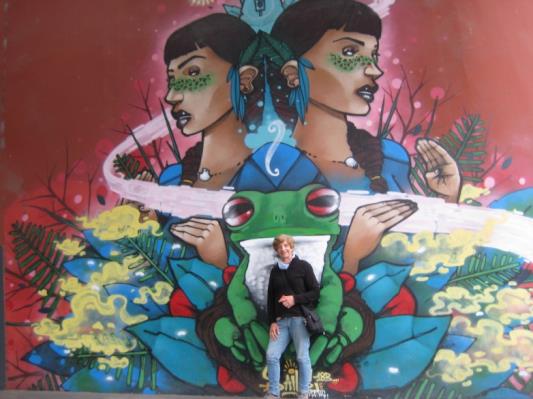
Lima: Street art in Barranco |
30th July
Back to Lima Again!
We returned to Lima after our train excursion to Huancayo, and left two days later on a flight to Iquitos. On our rest day in Lima we took a tour of some of the more interesting quarters by the sea.
Lima Day 2
On our second full day in Lima we had booked to explore Lima’s Colors and Flavors with Haku Tours. Our hotel transfer arrived promptly and took us to the tourist quarter of Miraflores where we picked up a family of Americans from an American hotel. With a full minibus we headed to the seaside port of Chorrillos. Given the quantity of fish consumed in ceviche in Lima we were expecting to see a large commercial fishing fleet in the port, but instead there were only small boats sitting on anchor. The fish market at the port had long since sold out so we were not able to see the fish they catch. On the top of the cliffs was the local market where we had a tasting of the more unusual fruits on sale. Their dragon fruit was yellow and sweet, custard apples were green, lemons green and limes larger and yellow! Moving to a second market we waited for seats in a popular local restaurant (Chanfainita Pale). When we all got stools to sit on we tried two Lima staples, Ceviche and Papa a la Huancaina ( potatoes in a mild yellow sauce made from Aji Amarillo). The former was more to our taste. We were surprised to learn that in Peru the raw fish for ceviche is only marinaded in lemon juice for a few minutes.
Walking through the market we exited onto Av Jorge Chavez where there was restaurant serving Amazonian dishes – Comida de la Selva . There was plenty of room upstairs where we sampled fried plantain balls with chunks of smoked pork. The pork was very tasty.
Our final stop on the tour was Barranco, the Bohemian quarter of Lima. Like Chorrillos this was an authentic district as it didn’t have hotels. The minibus dropped us in the main square where the old tram station is now a library. The architecture in this area was reminiscent of Cuba, except not so dilapidated. As we descended the Oroya steps our guide explained the street art painted on the walls. At the bottom was the pedestrian Bajada de Baños with trendy restaurants and bars and a view out to the sea. At the top of the street it was crossed by the wooden Bridge of Sighs, but more interesting were the murals painted on the underside of the nearby road bridge illustrating the diversity of races that make up Peru.
That evening we returned to the good restaurant on Plaza San Martin to sample more gourmet ceviche. This time Adrian had a chili hot ceviche with black shells. There were no street protests this night so we were able to look at the night life in the Plaza before heading back to the hotel. Even though the weather was mild to us, many of the dogs being walked had coats on.
231st July – 3rd August
Iquitos
Iquitos deep in the Amazon forest was added to our itinerary at the last minute when another trip in northern Peru became logistically impossible. It turned out to be an inspired choice; the tropical humidity and feeling of being in a remote outpost of civilisation was a complete contrast with the cold and blue skies of the high Andes. It was a city that grew on one with time, with a fascinating history of Spanish discovery and then the rubber barons, and a relaxed friendly lifestyle. But it was a day trip to the wild monkey refuge an hour down the Amazon that really made this part of the holiday memorable for us. Interacting with New World Monkeys was unexpectedly captivating and it was gratifying to do something to support such a worthwhile charity.
Iquitos Day 1
We finally said goodbye to all the warm clothes and packed them in our big suitcase to be left behind whilst we travelled to the Amazon. As we took a taxi to the airport Lima woke up to yet another colourless grey day. Things were running smoothly at check-in thanks to the Pan-American Games being in full swing. We dropped off our suitcase in the exorbitantly priced left luggage office, and headed upstairs for a cup of equally exorbitantly priced coffee.
After two hours of flying we got our first views of jungle and wide brown rivers as the plane came into land. Iquitos has the distinction of being the largest city in the world with no access by road, so the smart car that picked us up to take us to the hotel was a bit of a surprise. Our hotel for the next few days was so new it was not shown on Google Street View. It was run by a lovely lady who didn’t have a word of English! Our room in the Fitzcarrald Hotel had a very efficient A/c which was welcome as we adjusted to the heat. It also had hot water, but only in the shower. And like most hotels in Iquitos it had Wi-Fi, but the connection to the outside world was painfully slow.
After settling in we took a walk round the centre of town and rewarded ourselves with an ice cream. After visiting the bank we were cashed up for evening cocktails (Machu Pichu and Pisco Sour) in the Arandu Bar, followed by dinner outside overlooking the water in the Dawn on the Amazon restaurant. The service at the latter was so slow there was a danger of it being dawn before we got the bill!
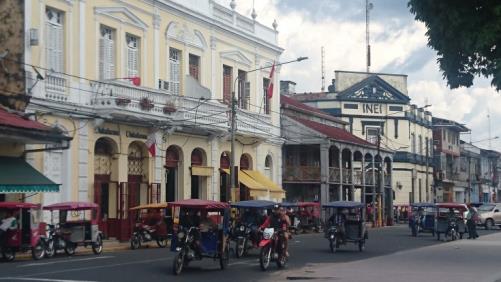
Iquitos street scene |
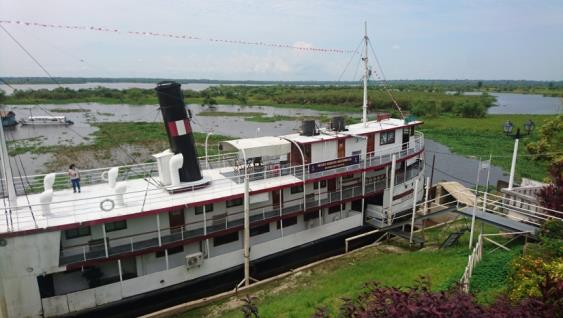
The Ayapua steamboat |
Iquitos Day 2
Our hotel offered a fresh cooked breakfast in a tiny room that only had 4 tables. The owner of the hotel was very concerned about the arrangements we had made to visit the Isla de los Monos (the monkey refuge). She was convinced that we were being duped. Adrian went round the corner to check the office of the charity that runs the island, and met the refuge founder Gilberto and his assistant Lucero. After leaving a sizable donation to the charity we were booked onto a private visit to the island the next day.
There were plenty of cafes in Iquitos, it seemed that drinking and eating were more popular pastimes than working. After joining the locals for a coffee at Maria’s cafe we headed to the Museo Barcos Historicos. This museum was in an original steam river boat, The Ayapua, containing a collection of interesting exhibits about the early days of sailing on the Amazon. Megan particularly enjoyed the original books and diaries describing early travels on the river. After having toasted sandwiches for lunch in the trendy Karma Cafe we went to the second museum in town, the Museo de Culturas Indiginas Amazonicas. This old building on the Malecon gave a fascinating insight into all the diverse tribes in the Amazon and their differing cultures.
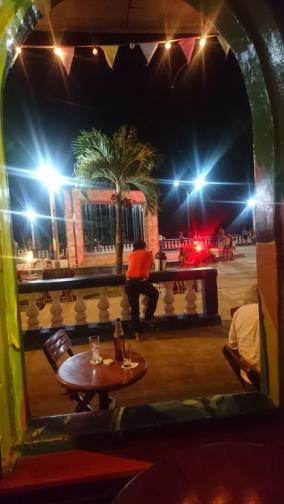
Cocktails on the Malecon |
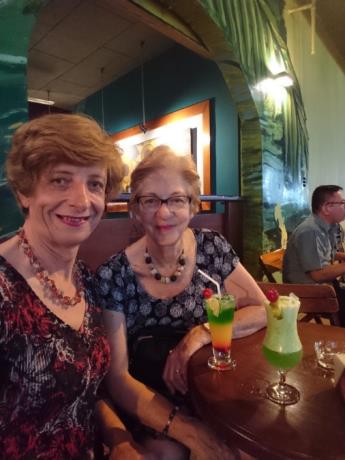
Cocktails on the Malecon |
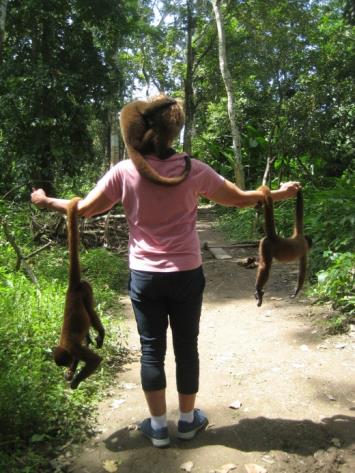
Adrian and hangers-on |
When the sun went down we joined the crowds on the Malecon,, having cocktails again at Arandu and then selecting a different restaurant for our dinner. The meal in El Meson was pretty average but the bill came quickly!
Iquitos Day 3
On our last full day in Iquitos we took a trip to the Isla de los Monos to see the refuge for rehabilitating wild monkeys. After breakfast we walked round the corner to the office where motor taxis were waiting to take us down to the Amazon port at Nanay. It was a breezy dusty trip but we enjoyed the experience of riding in the three-wheeler down a busy road. To get to the taxi boats we had to walk through the chaotic local market where plenty of fresh fish were being sold on the ground. Our fast boat left from a floating pontoon which we accessed over the mud flats on a rickety gang plank.
The Amazon was wide and brown as we had imagined, but it also had a lot of floating logs and plants. On many occasions the taxi boat had to stop and reverse to shake off plants that were wrapped round the propeller. As well as other taxi boats there were commercial barges on the river being maneuverered by four storey tug boats. After about an hour we turned into a side creek on the right hand bank, and soon afterwards were mooring up against the island’s jetty.
Isla de Monos
As we stepped off the boat we were warmly greeted by our guide Jair and given an introduction to the refuge. Even though there were plenty of mosquitos we were asked to wash off insect repellent as the monkeys don’t like it. The refuge had three huts connected by walkways high above the wet season floods. One was an information centre for visiting groups, one a kitchen and the third accommodation for the volunteers. Unlike the constant stream of tourists who came for ½ hr to see the refuge, we had our own guide for the day and were given a much more in depth experience.
We hadn’t realised how different the New World monkeys are from those we were familiar with in India and S.E. Asia. They have a flatter face and most of them can use their tail for grasping things. The refuge introduced us to many types of monkey including TiTi, Pygmy Mamoset, Howler, Spider and Woolly. We thought they were all cute! The refuge also had a resident rescued macaw whose vibrant plumage had now grown back.
Jair first introduced us to the baby orphan monkeys being looked after and the new arrivals that were in quarantine. One of the orphans took an instant like to Adrian and soon she was walking round with 3 hangers on. We had a short walk in the jungle (with the babies) before going to the volunteers hut for a cool drink. Leaving the baby monkeys behind we then took a much longer walk looking at jungle trees, birds and the occasional wild monkey they had released. There were frogs, tiny birds, and three different coloured woodpeckers. We also saw a Sloth, sitting lazily in a bush much like Koalas. Jair was proud of all the trees he had planted to provide food for the monkeys. Trees grow very quickly in the Amazon, but this forest only had saplings as the understory because of the annual floods. The flooding also gets rid of snakes and other ground lovers from the island making it perfect for monkeys.
Our generous lunch had many dishes including two types of tasty fresh river fish; after which we were in need of a hammock siesta. When Megan came out she was still a bit sleepy and had her glasses lifted by a mischievous monkey. The monkey held the glasses with the tail, leaving all four limbs to play a game of being chased under the huts. The glasses were eventually retrieved. Exhausted by the excitement and the heat we spent rest of our visit sitting in the shade watching the monkeys play.
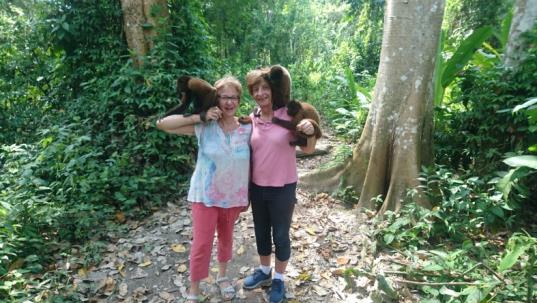
Quality monkey time on Isla de los Monos |
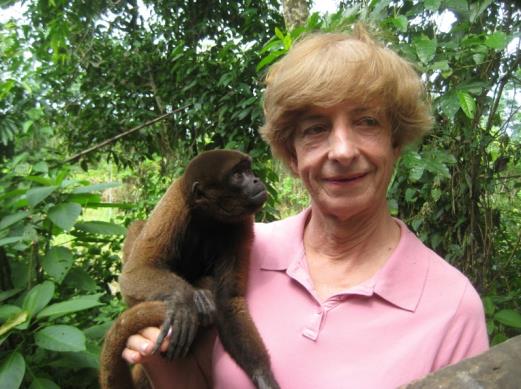 |
Too soon it was time to head back to Iquitos after a relaxing day with monkeys. Thunderstorms were brewing as we headed back up river to Iquitos but only a few spots of heavy rain fell on us. A motor taxi took us back to the hotel by 4pm.
Having run out of options for a local dinner we opted for the upstairs balcony of the gringo Antigua Pizza restaurant, dining early before the tour groups arrived. We had a surprisingly good moist pizza with a thin crust.
Iquitos Day 4
A relaxed morning was on the itinerary before a flight back to Lima. The hotel wanted to be paid in ‘effectivo’ (cash) so we visited the ScotiaBank ATM for the last time, and then had coffee in elegant but pricey cafe on the Malecon. After we checked out the happy hotel staff wanted pictures with us so we obliged. There was no smart limo transfer back to the airport; the taxi we hired was more typical of Iquitos cars; battered and broken but still mobile.
At Iquitos airport we once again availed ourselves of the priority boarding for anyone over 60, so we could get on the plane with our carry-on before the overhead lockers filled up. The flight left 15 min before the advertised time but was otherwise uneventful.
Back in Lima airport we recovered our big suitcase from storage and found they charged by the day not by 24 hrs, so their rate was even more expensive. To save time on check-in the next morning we tried to print our boarding passes and bag tags but couldn’t get a passes for the second leg with Qantas from Santiago to Sydney. This was worrying as we had a very tight connection ticketed in Santiago and we were wondering if the lack of boarding passes meant they would put us onto a later and less convenient flight.
The receptionist at the airport hotel remembered us (Adrian?) from our last visit. We had however forgotten that the Crowne-Plaza charged for drinking water, so we had to return to the airport to buy water. Then after enjoying a strong complimentary Pisco Sour, the last of the holiday, it was back to the airport again to eat. We found a new restaurant, Haytu, in a quieter part of the departure level and had a final ceviche.
4th – 5th August
Heading Home
Every holiday has to end, and with so many experiences of South America we couldn’t cram anything more into our heads. A good end to a holiday, if there is such a thing, is one that goes smoothly and the trip home is comfortable. Instead of long connections, our trip home was direct and left no time wasted in airports. It finished off a great holiday in style flying Qantas Business Class.
We were up at 4:30am to allow for delays in checking-in but there were none, so we found ourselves in the VIP Lounge just an hour later. Our flight to Santiago left on time with Business Class almost full. Most of the other passengers slept the leg, maybe because the breakfast they served was pretty average. After three hours the flight arrived a bit ahead of schedule at Santiago but at a gate in the old terminal. This meant that after going through the transit security check we had a long corridor walk to the new terminal where our flight to Sydney was in the early stages of boarding.
For the first time we were seated in the front downstairs section of a 747-400. Being on a Qantas flight made us feel we were back home already. The service and food were great; a far better direct flight home than our long LATAM flight out. We arrived in Sydney just as the sun set, and got home quickly by train and bus. Sydney had been unseasonably dry and hot in our absence so the garden was stressed, but otherwise everything was OK after a longer than usual time away.
